Taste of Spain: 25 Must-Try Traditional Dishes
Written by Nadia Podrabinek
Hello, my name is Nadia. I usually write about traveling (there are so many places to fit all the lifestyles), relocation, and living in a foreign country (adapting to a different culture). My travels stretch beyond Spain, with journeys to the US, Italy, Norway, Portugal, and France. Relocating to Spain in 2018, I lived in cities from Barcelona to Madrid, currently calling Valencia home. Follow me on Twitter, Facebook, Instagram, or LinkedIn! ... show more
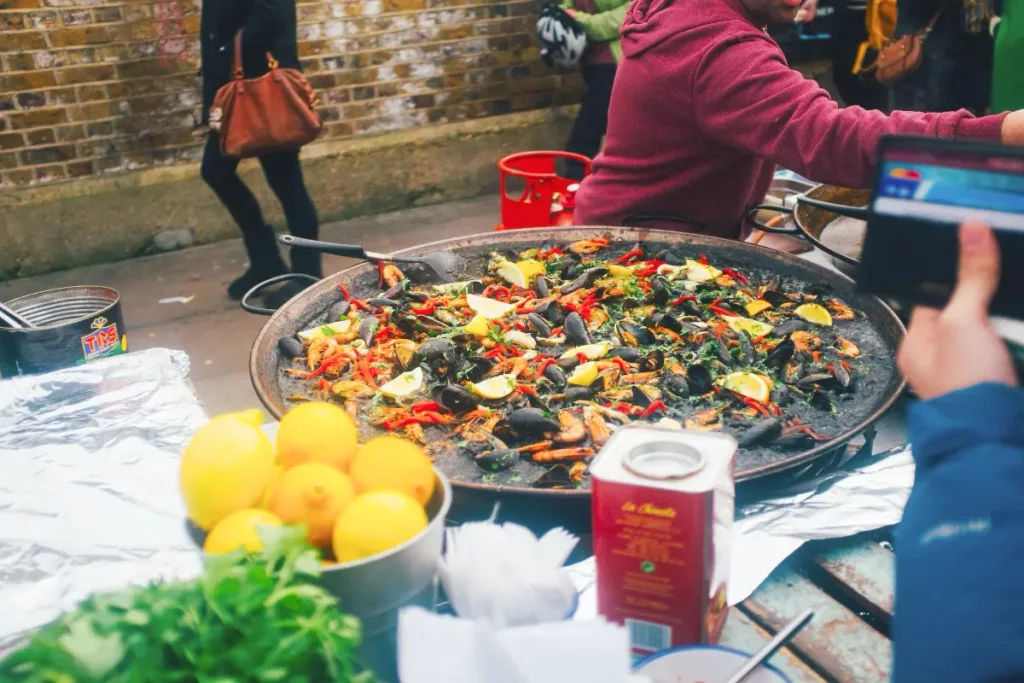
Spanish food is one of this kingdom’s most attractive and unique features.
Greeks, Romans, Moors, and Arabs have helped shape the diversity found in Spanish cuisine today – making it truly one-of-a-kind! It’s no surprise that gastronomic tourism is so popular in this country.
At first glance, some Spanish dishes may seem too simple to praise. However, you should try them; genius lies in simplicity!
Good to know Food culture is very important to Spanish people. The main reason it has such significance is that it was scarce during Franco’s rule (when there was famine throughout Spain).
This period left a deep imprint on many generations affected by hunger and poverty, making them highly aware of how precious food can be. As a result, Spaniards cherish their traditional food recipes that have passed through time.
So, what do they cook in Spain?
I will list the 25 examples of popular food in Spain, with some hidden culinary gems I have found having lived here for 5 plus years.
What people say on Reddit
Food in Spain is extremely local. It would be a bad idea to try and eat something which is a specialty of a specific area somewhere else. It’s not that you won’t find good quality, you will, but it would be in highly specialised places that are very hard to find for a casual visitor. So I strongly recommend you do think about the local dishes of each place you are visiting. Find out what the speciality is in the place and find a decent place to try it. If you wanna eat paella, definitely try it in Valencia and not in Madrid. I would go as far as saying it’s better not to eat paella at all if you are only staying in Madrid for example, because Madrid has plenty of great food to enjoy. And the same goes for every single city, town and village here.
UruquianLilac
If you go to Barcelona, a real paella (not in a place for tourists) and a fideuá (same thing). Gazpacho, migas, and a real true cocido in Madrid.
lorajoler
Nobody remembers croquetas, which I think are, alongside tortilla de patatas, the most iconic spanish dishes. Because everybody knows paella, but that belongs to the mediterranean part of spain, specifically Valencia. So I’d say tortilla de patatas, croquetas and probably some churros with your coffee at breakfast. This makes a pretty spanish treat.
Jaminito
In Madrid I’d recommend you to eat cocido at Malacatín. They have other typical dishes too, but cocido is a need! Also go have tapas and raciones; tapas are free with your drink, may depend on the place from some chips/olives to a small plate of food. Raciones are a plate bought to share, we usually ask for a few different things. Most typical are huevos rotos, patatas bravas or alioli (mixtas would be with both sauces), corquetas, jamón/queso/chorizo, calamares a la romana… I’m probably missing something. You can also ask for tortilla, pimientos de padrón, pulpo, berenjenas con miel, take a look at other tables to see how big/tasty looking raciones are 😛 And try a few different places in a row to get the full experience, drink + tapas, a ración here, a ración there…
loggeitor
25 Best Spanish Dishes to Try at Least Once
Appetizers and Small Plates (Tapas)
In Spain, appetizers and small plates are typically referred to as tapas.

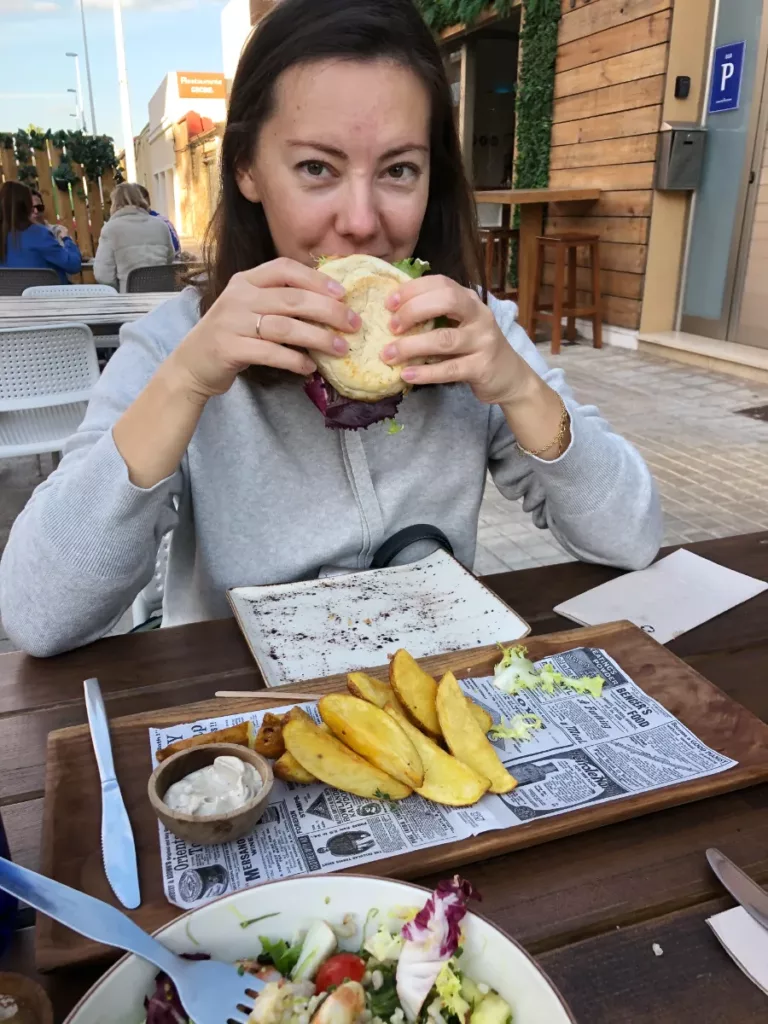
The origin of the word “tapas” is a bit contested, but it is believed that in the 19th century, King Alfonso XIII was out hunting with his entourage one day when he stopped for some drinks at an inn near Cádiz.
At this time, taverns served free small snacks or “tapa” (literally meaning cover) with each glass to prevent flies from getting into them.
This became so popular among Spaniards that “tapas” culture still prevails today throughout Spain.
1. Patatas bravas
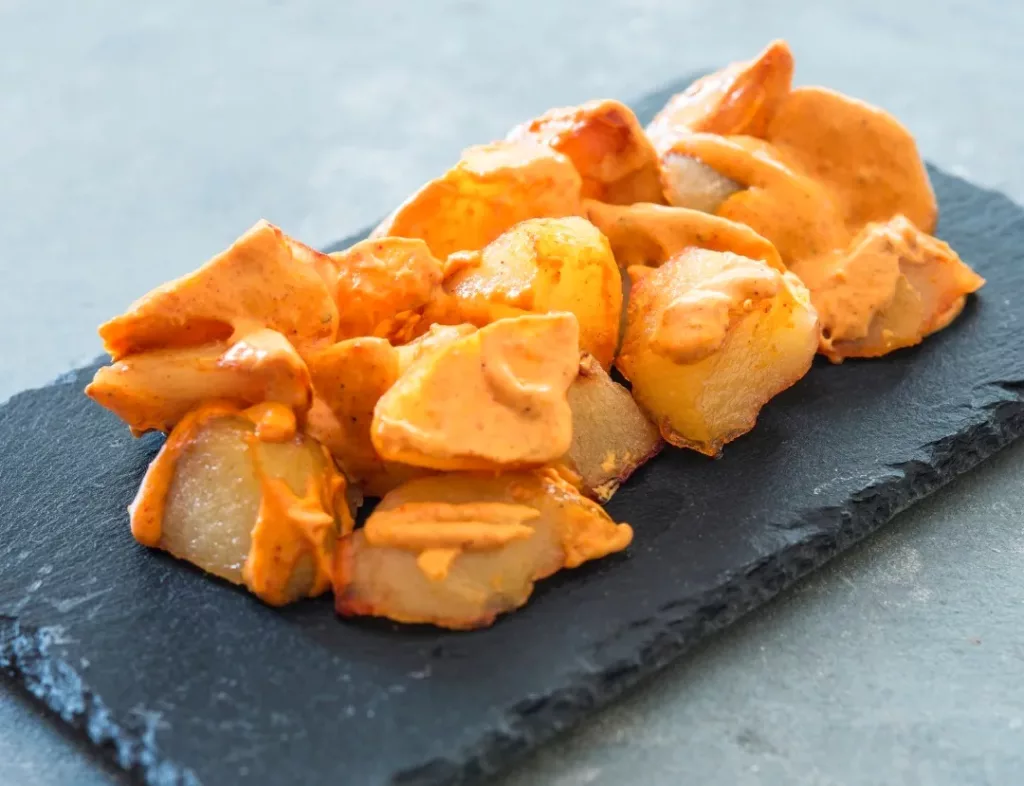
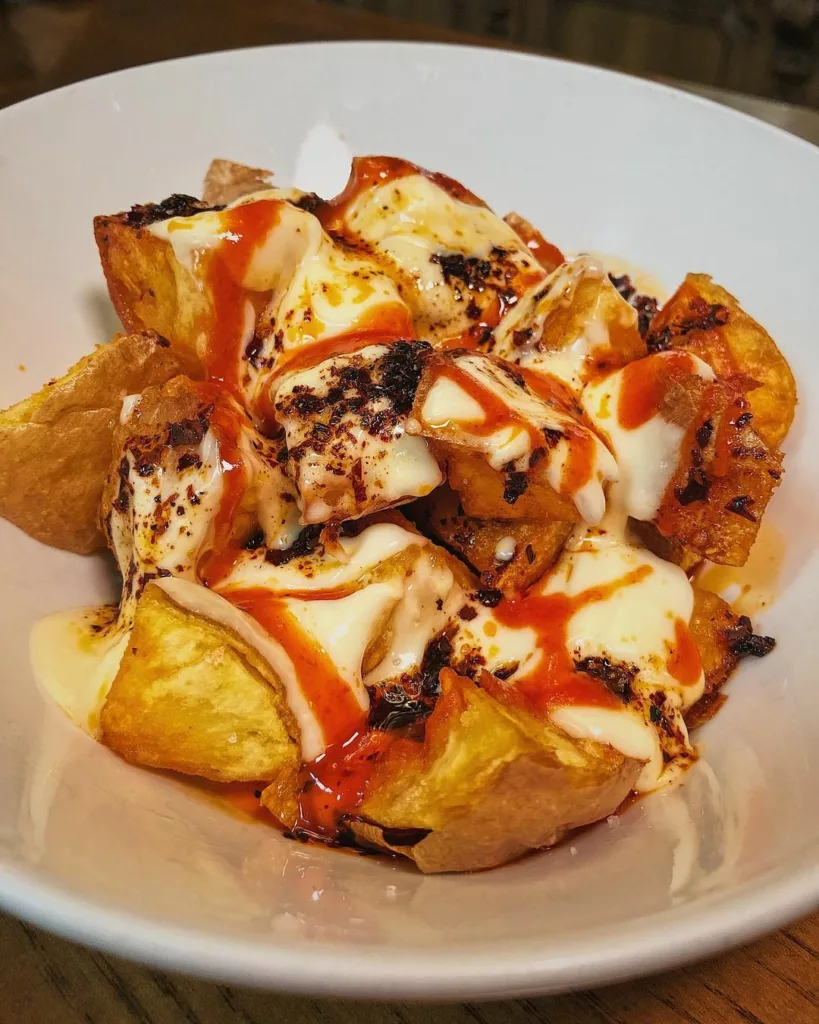
Actually, this popular and easy Spanish dish is re-a-a-a-l-ly delicious. If you have already tried it, you might disagree, and I will argue: You just don’t know how to cook it!
In Spain, patatas bravas are typically made with fried potatoes cut into cubes and then tossed in a spicy “brava” and aioli sauce.
The “brava” sauce is usually flavored with tomato, garlic, onion, paprika, and chili pepper. If you have high hopes for making patatas bravas by yourself, remember that making the sauce is not a simple task.
This dish has other names: patatas a la brava, papas bravas, spicy potatoes, or simply “potato wedges.”
The best patatas bravas I ever tried was in Paterna, a small town near Valencia. How did they cook them? The answer is simple: The potatoes were roasted over a fire, so they were incredibly flavorful.
2. Croquetas
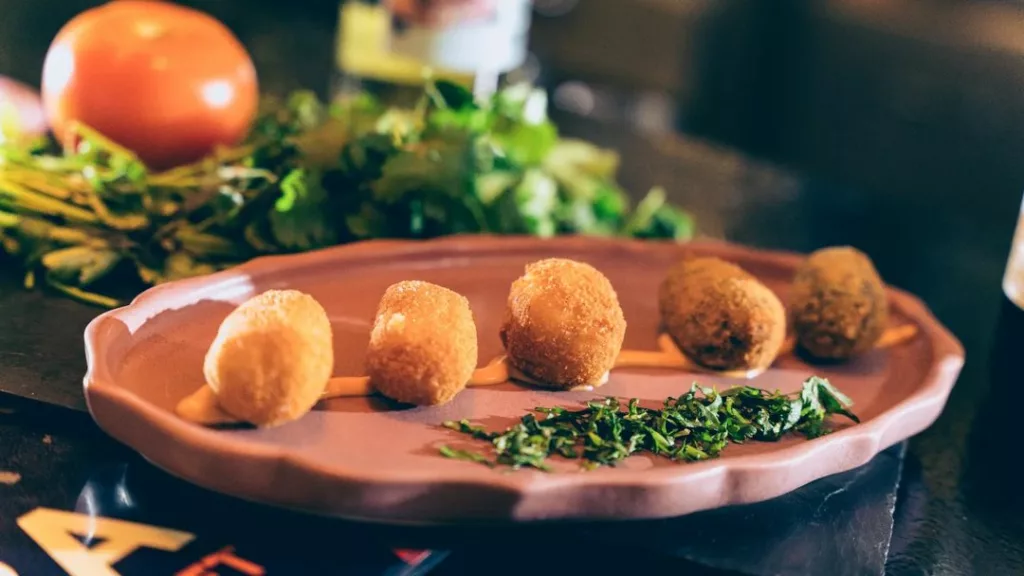
In Spain, croquetas are typically prepared by mixing ground meat and/or fish with béchamel sauce. This mixture is then formed into small balls or cylinders, coated in egg and breadcrumbs before deep-fried until golden brown.
There are many different types of croquetas in Spain, including:
- Croquetas de Jamón – Made with ham mixed into a creamy béchamel base.
- Croquetas de Pollo – Made from chicken cooked with vegetables like onion, garlic, and peppers for added flavor.
- Croquetas de Bacalao – A popular type of seafood croqueta made from salted cod mashed with onions, parsley, and other seasonings.
- Croquetas de Seta y Queso – Featuring mushrooms with cheese such as Manchego or Idiazabal blended into the mix.
Additionally, you may see Сroquetas Caseras or Croquetas de la Abuela. This is not about the filling; it’s referring to a style of cooking called “homemade” or “from Grandma.”
3. Gambas al Ajillo
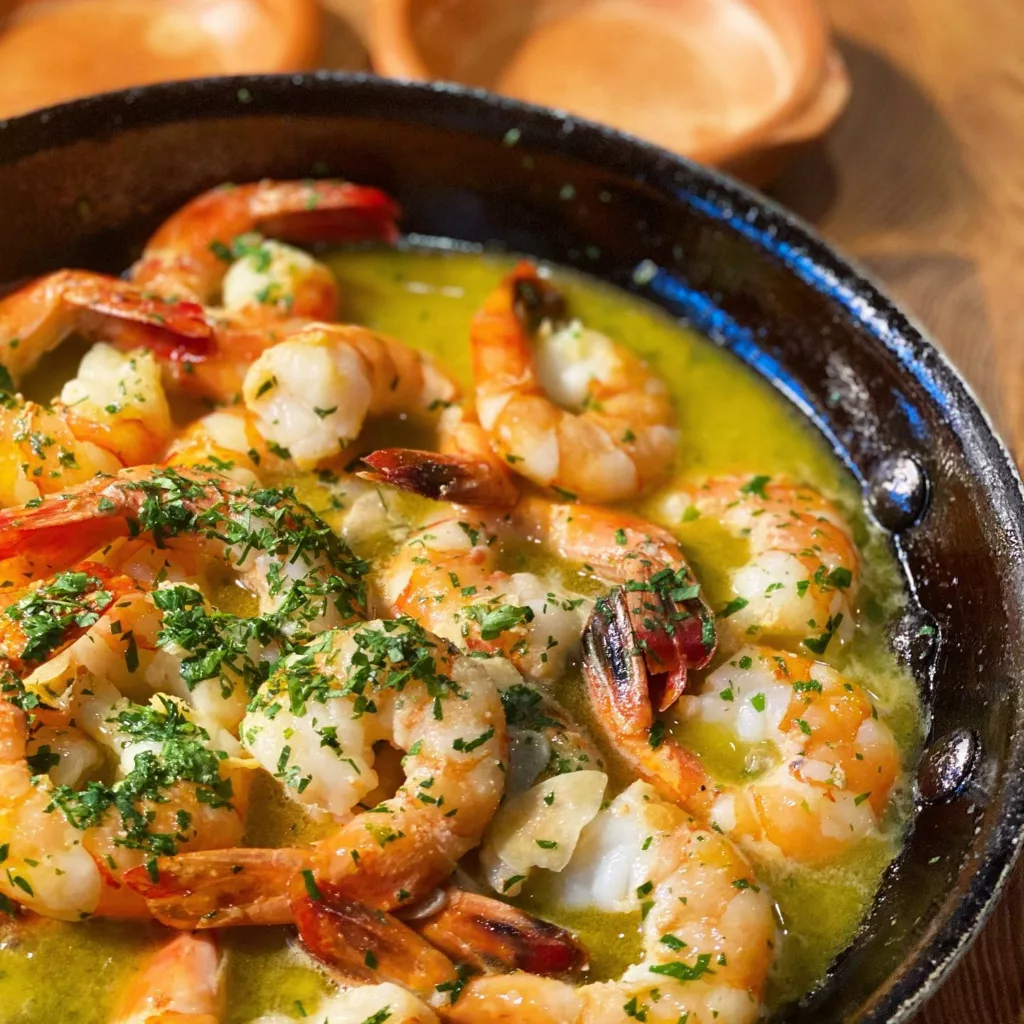
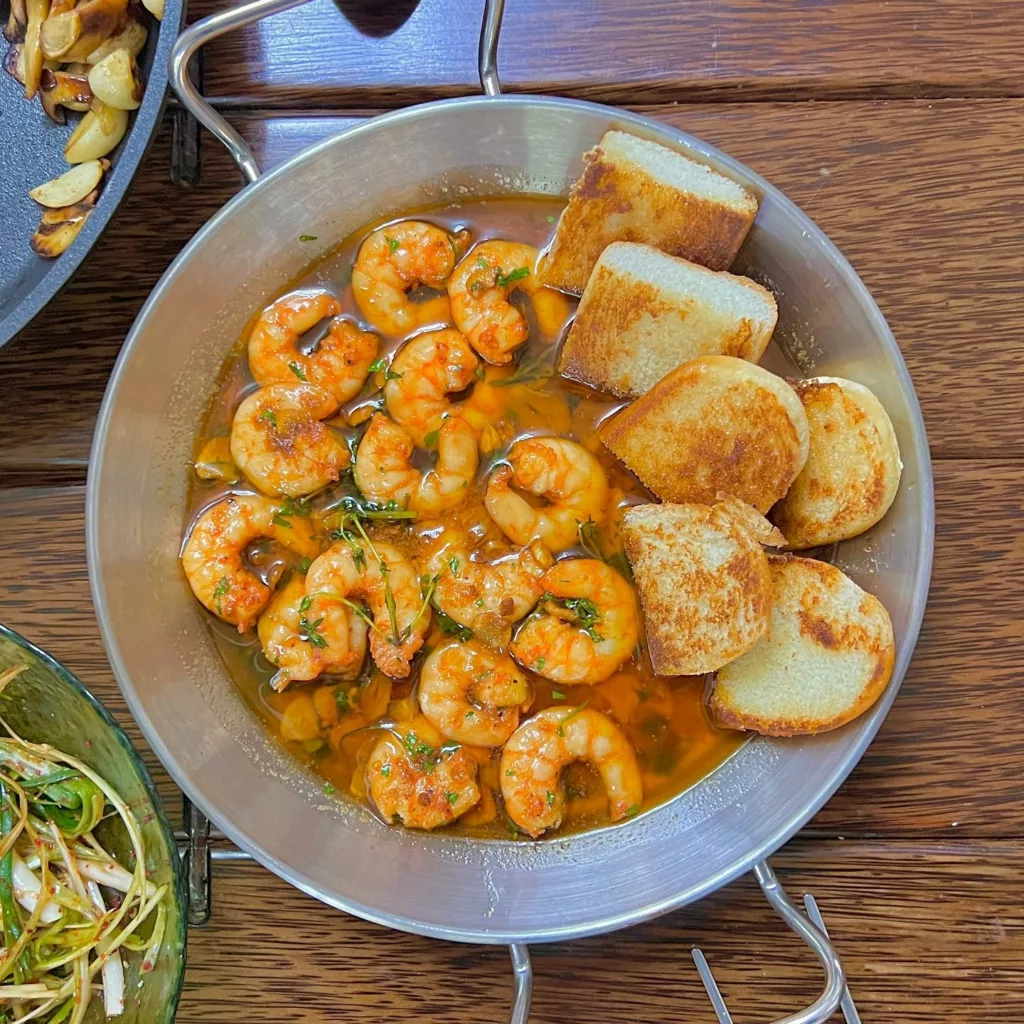
Gambas al Ajillo is a traditional Spanish dish comprising large shrimp cooked in garlic, olive oil, and chili peppers. It is often served as an appetizer or tapa but can make for a delicious main course.
The most common way to prepare it includes sautéing peeled shrimps with lots of garlic cloves (often five to six), dried red chilies (optional), and generous amounts of EVOO (extra virgin olive oil) until the shrimps turn pinkish-orange and everything turns fragrant from all that garlicky goodness!
Once ready, the final touch usually involves adding fresh parsley leaves for garnishing before serving alongside freshly made bread!
4. Pimientos de Padrón (Padron Peppers)
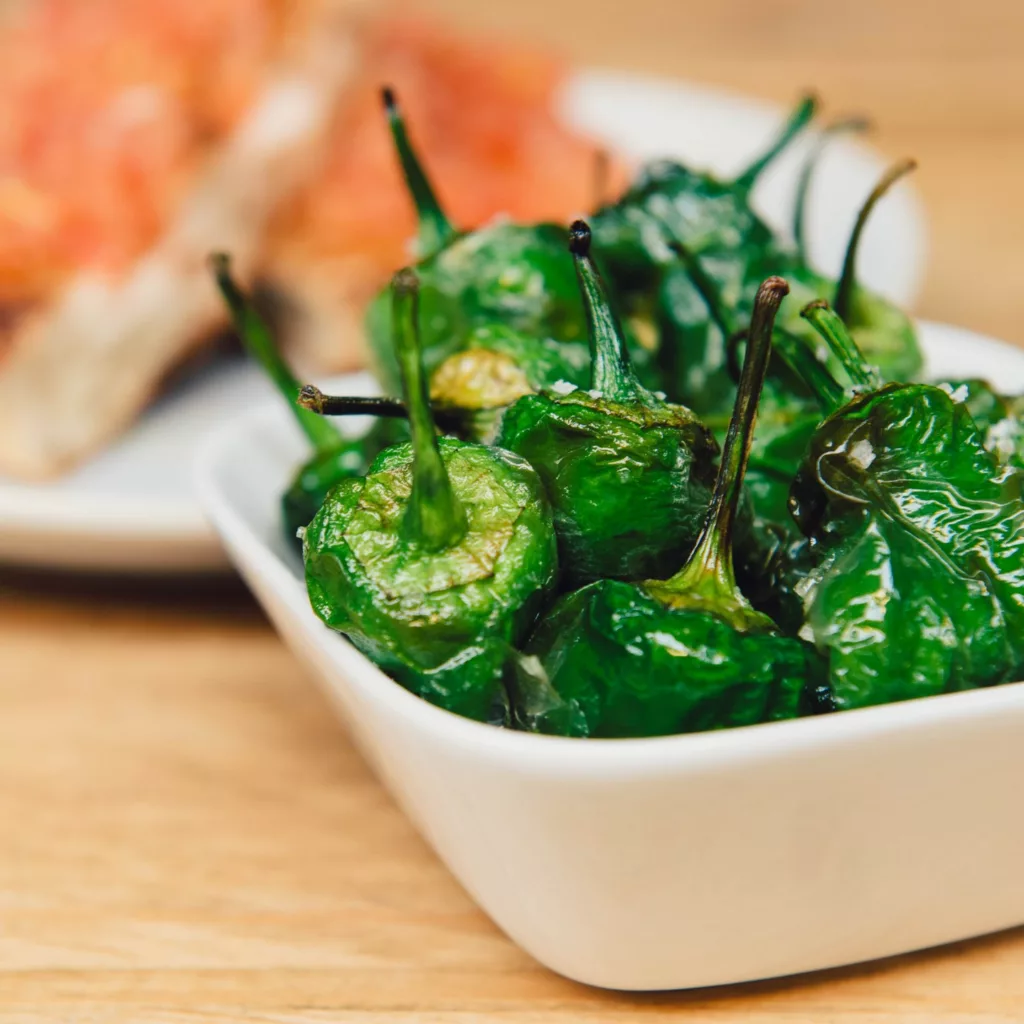
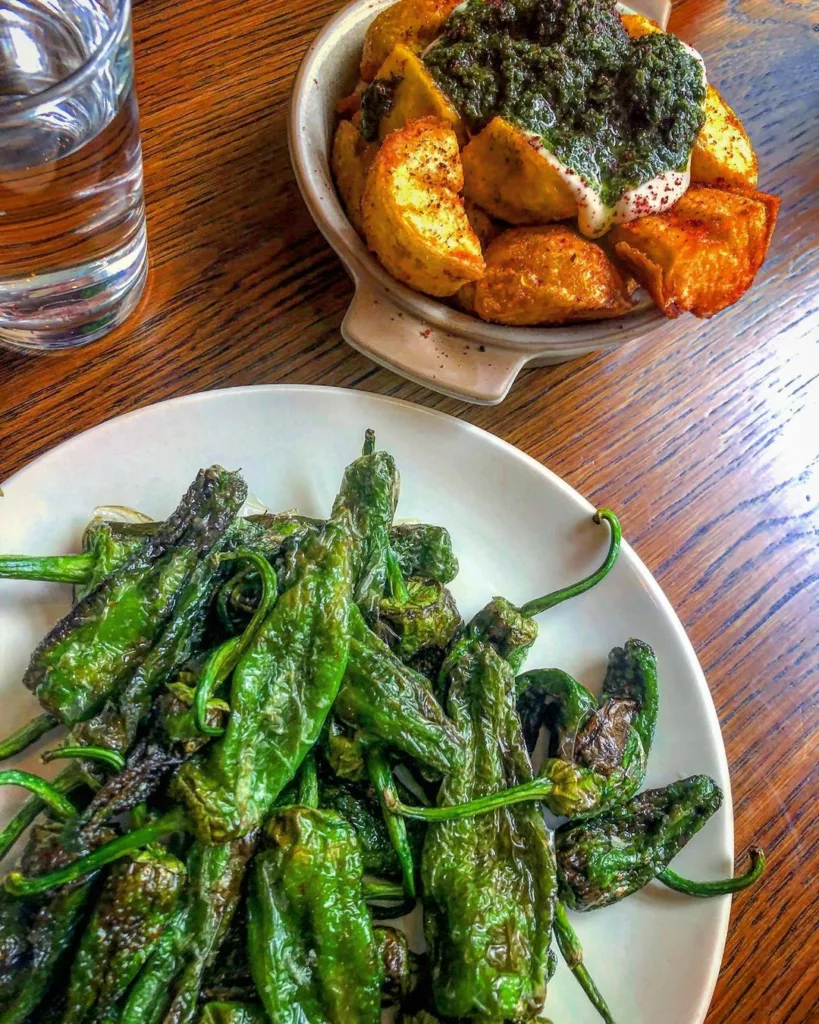
“Los pimientos de Padrón, unos pican y otros no,” – Some are hot, and some are not.
Pimientos de Padrón (Padron Peppers)
Pimientos de Padrón is an authentic Spanish appetizer made of grilled small green peppers.
The peppers, also known as “padrons” or “piquillos,” originate from the Galicia region in northwest Spain (near Portugal). The climate conditions in this region make the pepper sweet yet mildly spiced.
If you are not traveling to Spain and want to cook Pimientos de Padron by yourself – you may buy them from an online store like tienda.com.
How to cook: Put the peppers on a griddle pan/skillet over high heat for about 3 minutes per side until wilted and charred slightly at the edges (see the photo).
Also, don’t overcook; the tasty peppers are the crunchy peppers! Once done, transfer the peppers onto paper towels to absorb the olive oil and sprinkle them with sea salt.
5. Calamares Fritos
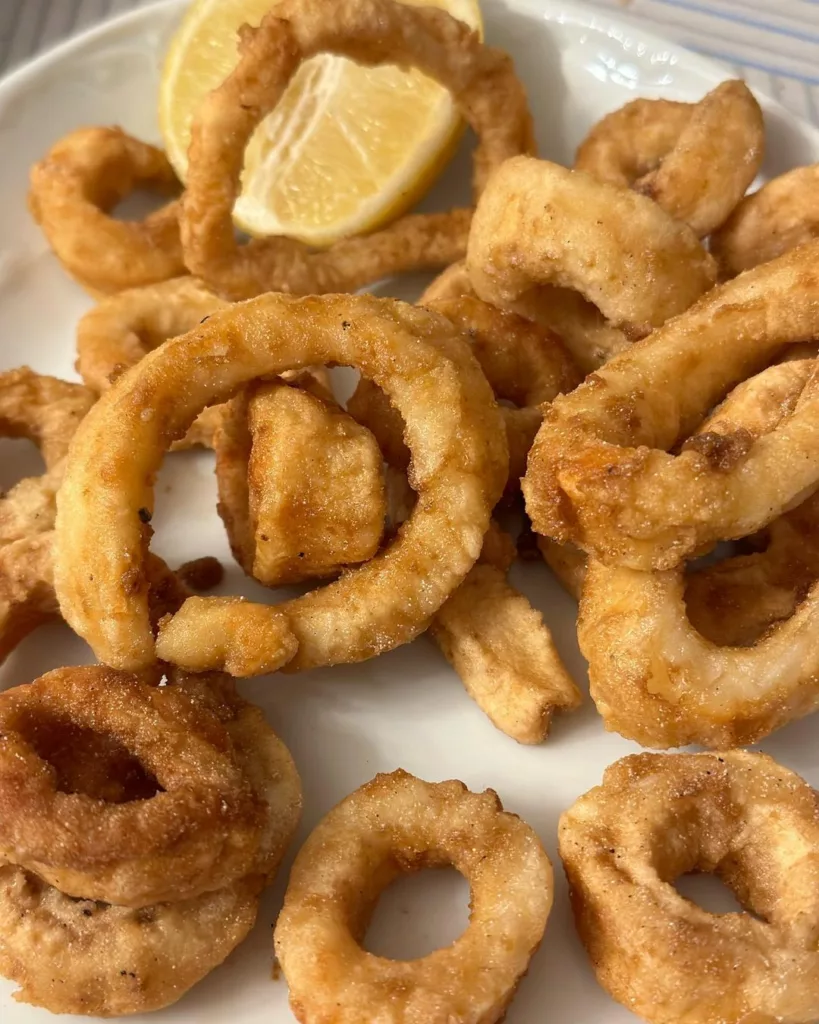
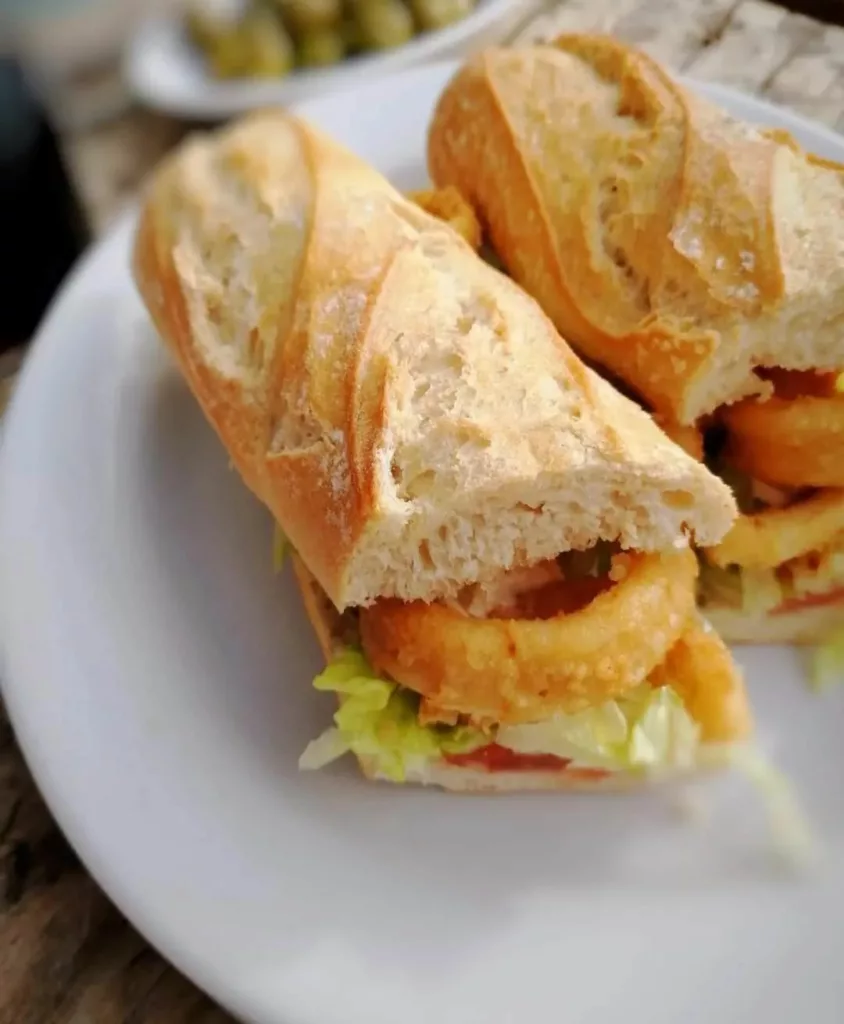
Calamares fritos is another Spanish tapas, this time of battered and deep-fried squid.
It can also be found in sandwiches called “bocata calamares.” Bocata calamares is a very typical sandwich in Madrid. And the texture of the squid rings adds an enjoyable crunch. Yummy!
Why is it so popular in Madrid? Perhaps due to Andalusia’s gastronomic and cultural influence in the 19th century, combined with factors like the difficulty of transporting fresh fish from coastal areas to Madrid and its popularity among locals in bars around Plaza Mayor in the 1950s.
Read also: 51 Things to Do in Madrid
How to cook: The squid must first be cleaned, gutted, and sliced into rings before lightly dusting it with flour or breadcrumbs. The pieces are then dipped into beaten eggs before coating with more flour or breadcrumbs and finally deep-fried until golden brown.
After frying, the calamari rings should be drained on paper towels so that any excess oil can be removed from them before serving.
6. Tortilla
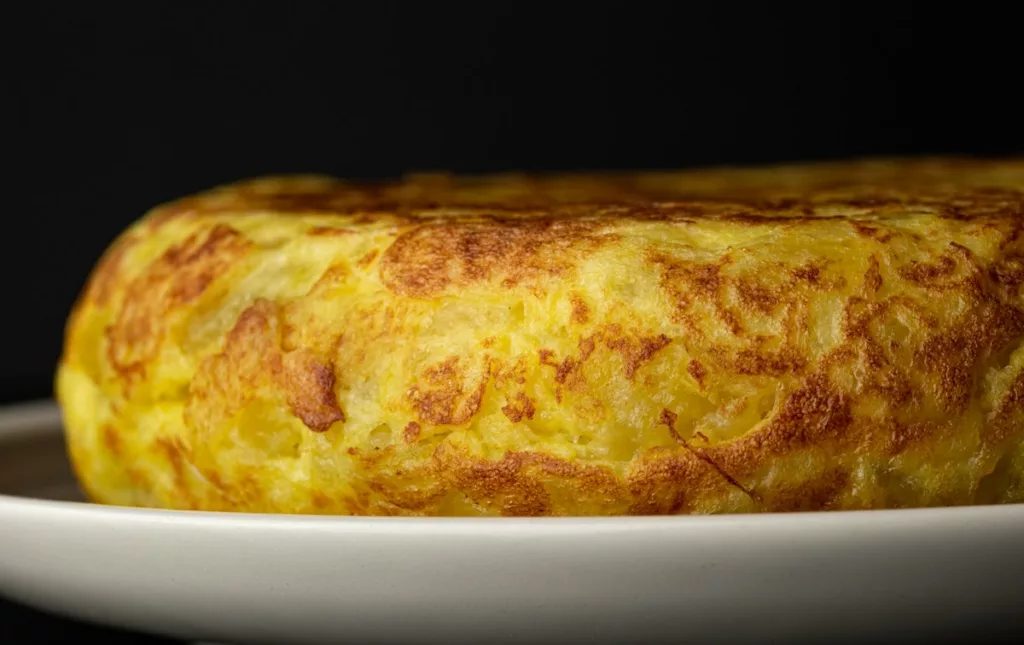
The Spanish omelet, or tortilla, is a classic of Spanish cuisine made with beaten eggs and fried potatoes. Additional ingredients such as onions or sausage can also be included.
It’s commonly served in slices of bread and often accompanied by a salad.
For an optimal result, the omelet should remain slightly liquid rather than dry; this is achieved by frying the potatoes with olive oil.
Useful Video
Soups and Stews
7. Gazpacho (Gaspacho)
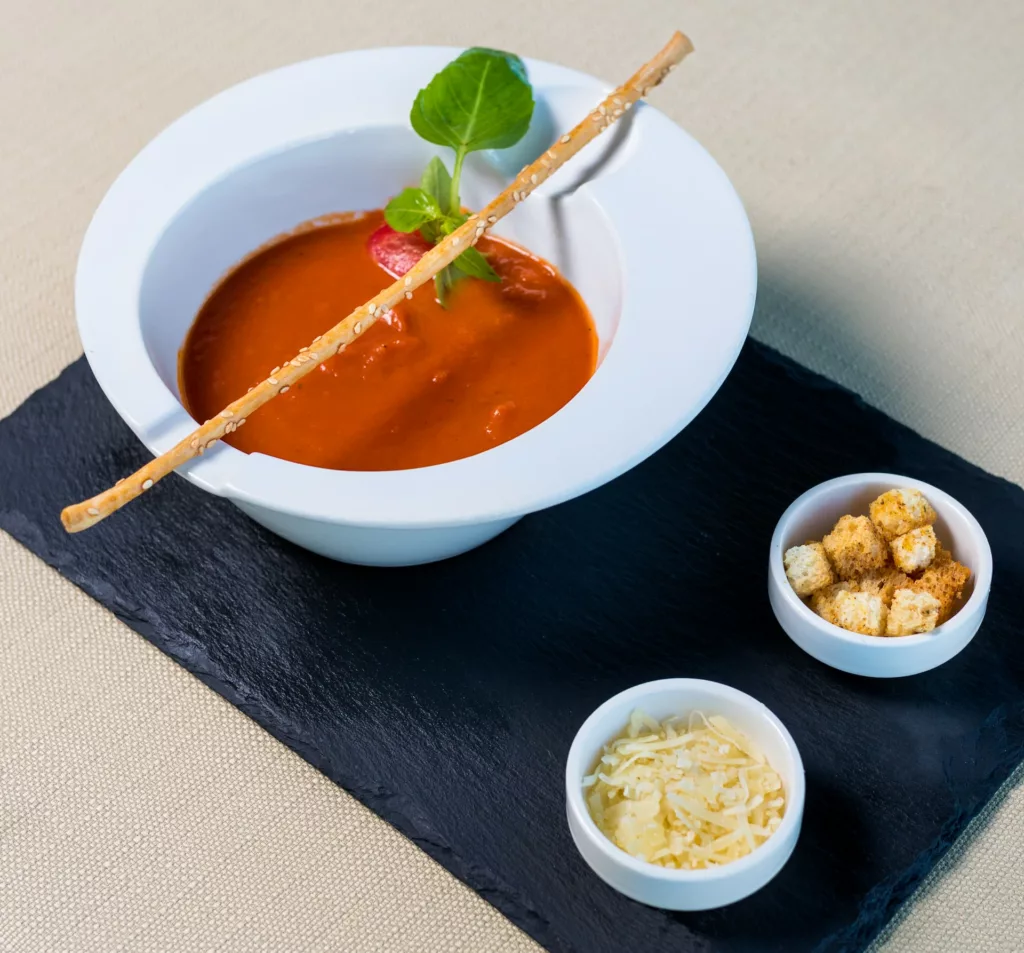
Gazpacho is a chilled tomato-based soup originating from Spain. It has been around for centuries and is still popular today.
Its name comes from the Spanish “caspa,” which means breadcrumbs/soaked bread.
Interesting fact Gaspacho was originally made using stale bread (!) as its base ingredient before tomatoes were introduced to the recipe in the 19th century.
I absolutely love this soup with cucumber, garlic, and small shrimp on hot summer days. Such a flavorful blend!
How to cook: Blend ripe tomatoes with EVOO, lemon juice, salt, pepper, and a tiny amount of onions and celery. Put it in the fridge, let it chill, add some chopped cucumber and garlic (but not too much), and that’s it!
8. Cocido madrileño
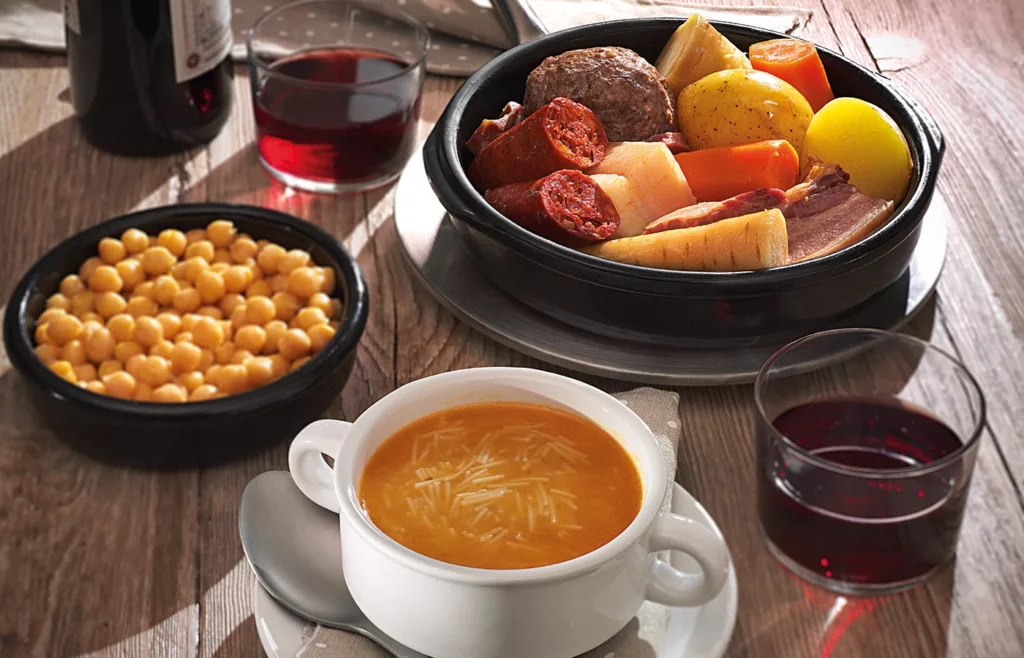
Cocido madrileño is a traditional and hearty Spanish stew originating from the city of Madrid.
It typically consists of chickpeas or broad beans, potatoes, carrots, chorizo sausages, morcilla (blood sausage), beef ribs or shoulder cut into cubes as well as other vegetables such as cabbage.
The name cocido comes from the verb “cocer,” which means to cook in Spanish.
The dish is said to have originated during medieval times when it was prepared by servants for their masters who resided in Spain’s capital city – Madrid. Over time its popularity grew amongst locals and eventually became one of Spain’s most beloved soups, with each region adding its own spin on how they like it cooked.
9. Sopa de ajo
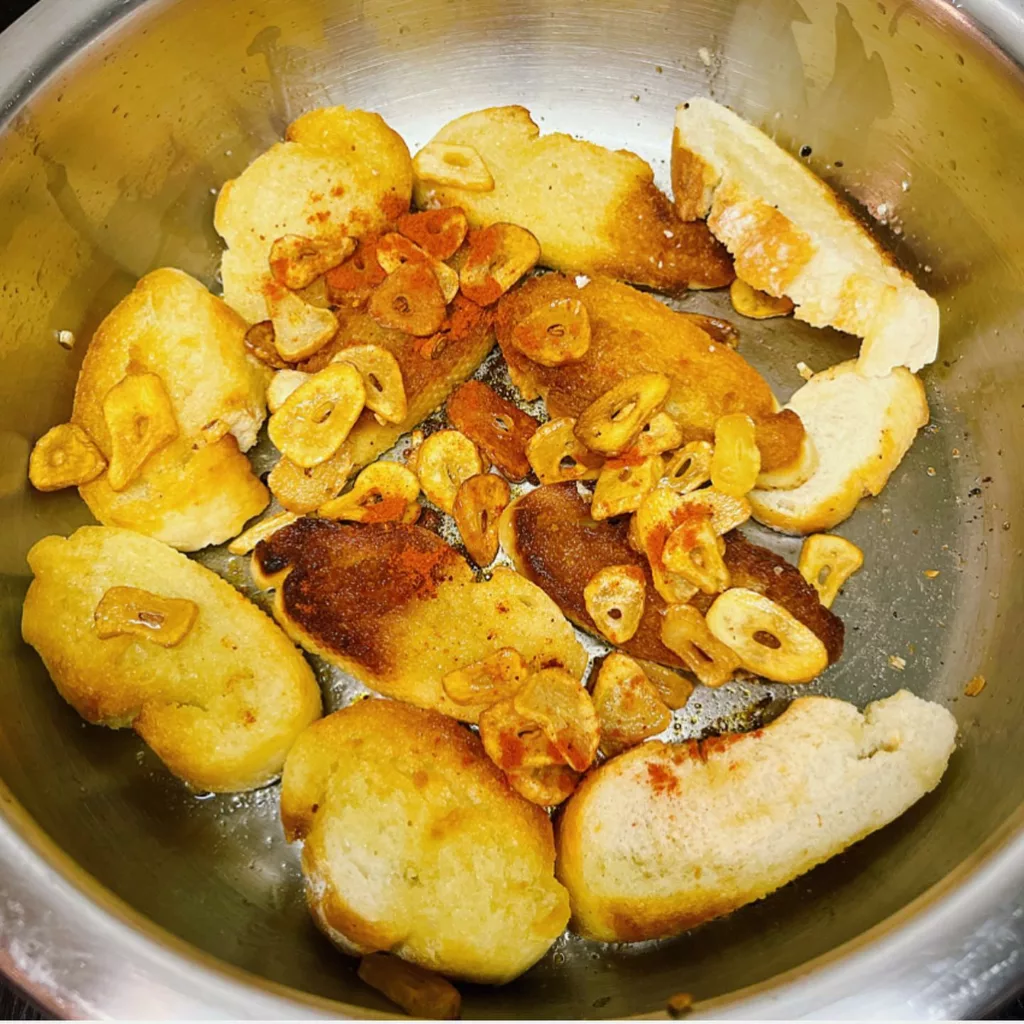
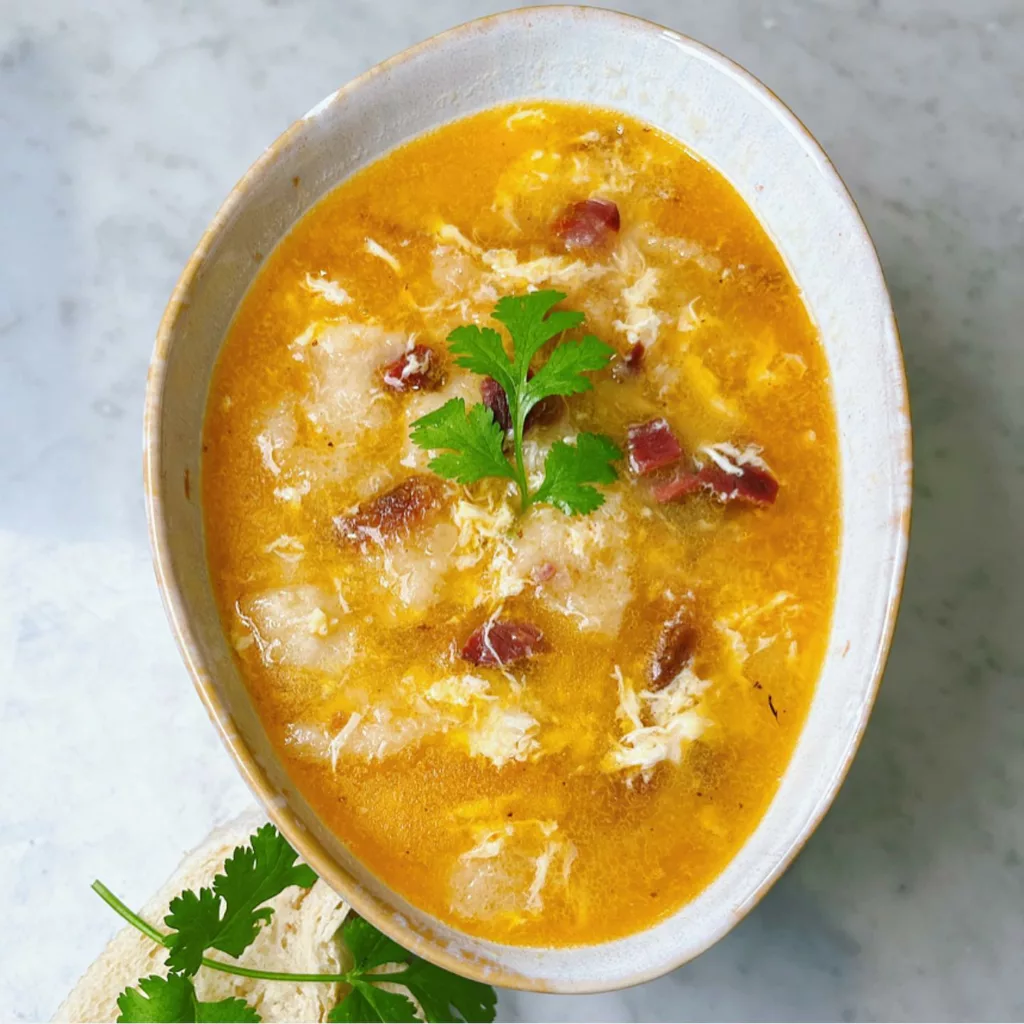
Sopa de Ajo (Spanish garlic soup) is an incredibly simple yet delicious homemade soup. It’s easy to make and is typically served during cold weather or Semana Santa (Holy Week before Easter).
It is said that this dish was invented by shepherds due to its uncomplicated ingredients while they were on their journeys with their flock. This soup has become very popular in Spain, as there are various recipes for its preparation.
The version which is often thought of as the original comes from Castile and consists of broth, garlic bread, olive oil, paprika, and eggs; however, other regional versions start off with this base but add additional items such as tomato or green pepper in Rioja or substitute cauliflower instead of pepper.
10. Salmorejo
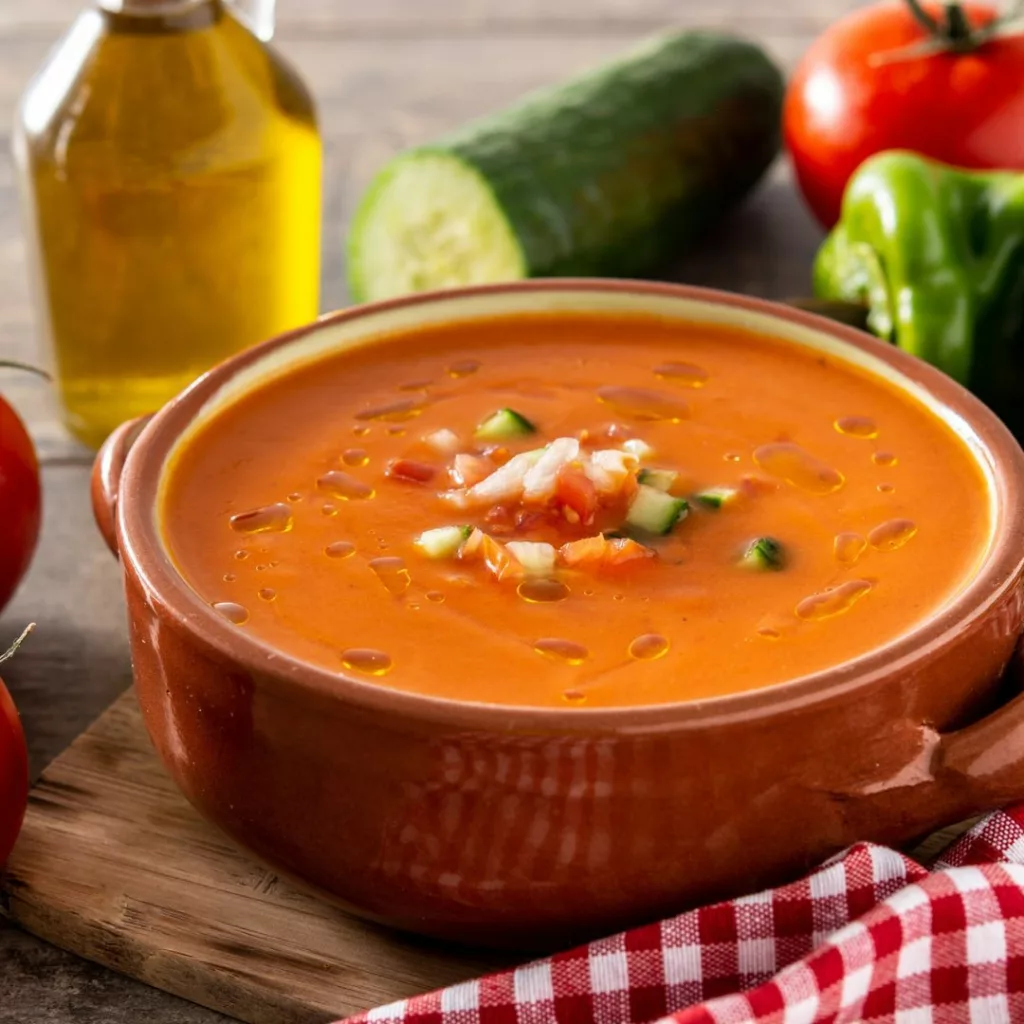
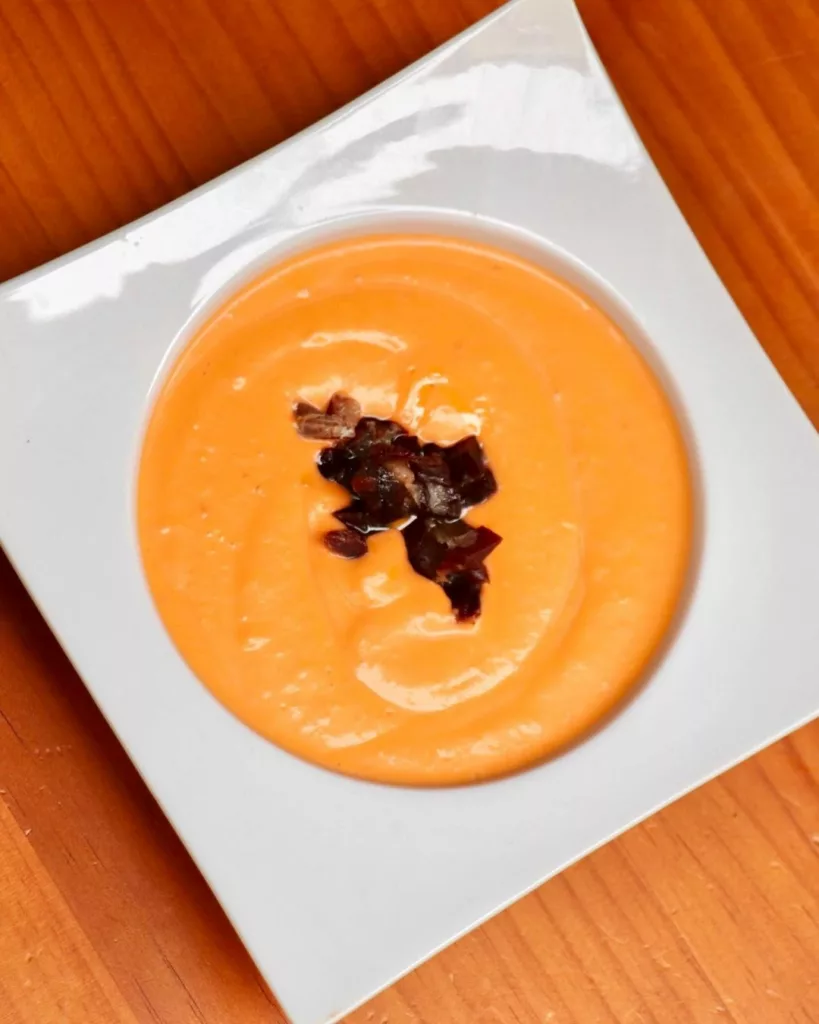
Spanish people are true masters of preparing cold vegetable soups, and the varieties and variations of recipes they have created seem infinite.
Salmorejo is a splendid example of such a dish made from mashed tomatoes, bread, olive oil, garlic, and sometimes vinegar; this is one of the signature dishes in the Córdoba cuisine of Andalusia.
The basics for salmorejo soup include raw tomatoes that have been passed through a sieve, along with white bread that has been soaked into the puree. Typically served alongside jamon or hard-boiled eggs (though rarely green peppers may also be added), its consistency resembles gazpacho.
The primary difference between these two soups lies in their consistencies. While gazpacho is quite liquidy and refreshingly light, salmorejo more closely resembles something like a thick sauce or puree due to the inclusion of bread and olive oil, which gives it an almost mayonnaise-like texture; it will not easily flow out from its container!
Interestingly enough, though, tomatoes were first introduced into European diets no earlier than the 17th century – at this time, being used mainly for sauces rather than soups! And because of its thicker consistency, you can actually use salmorejo as chips dip too!
11. Fabada
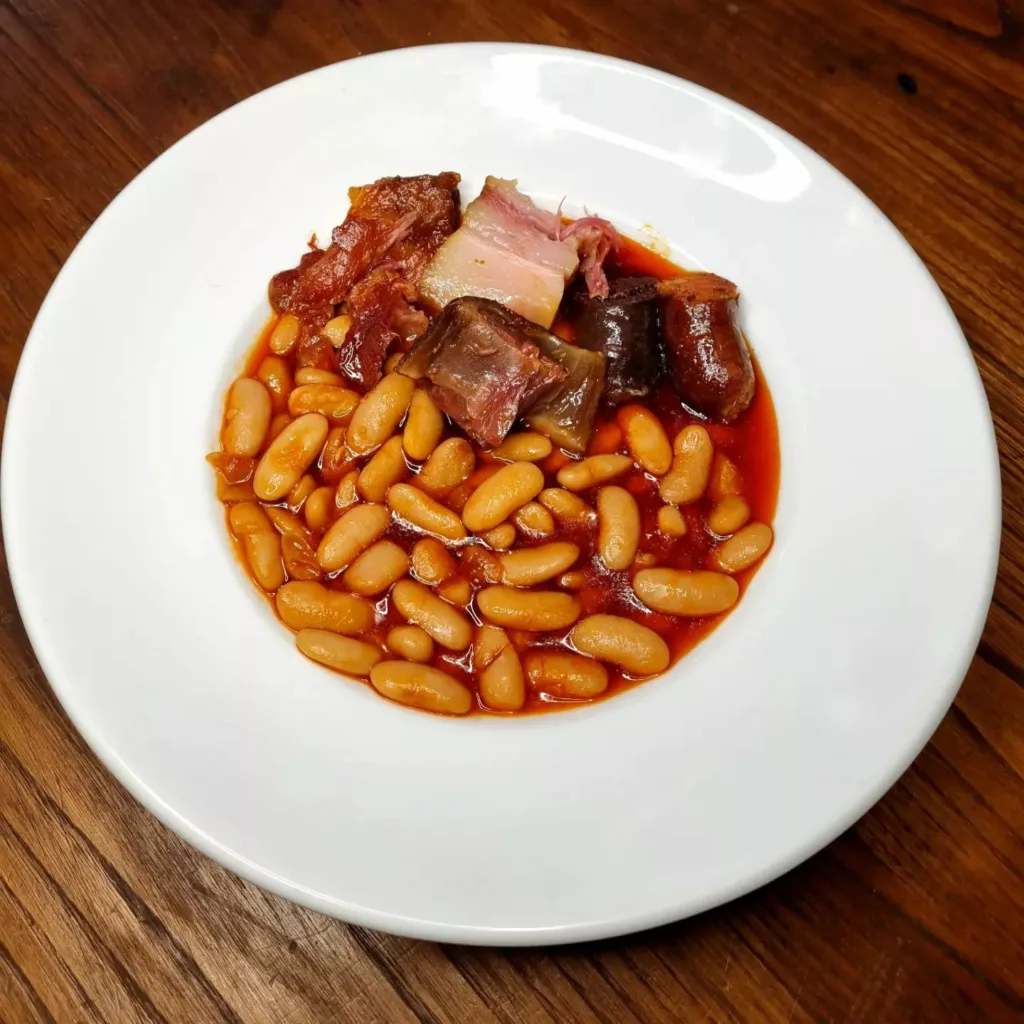
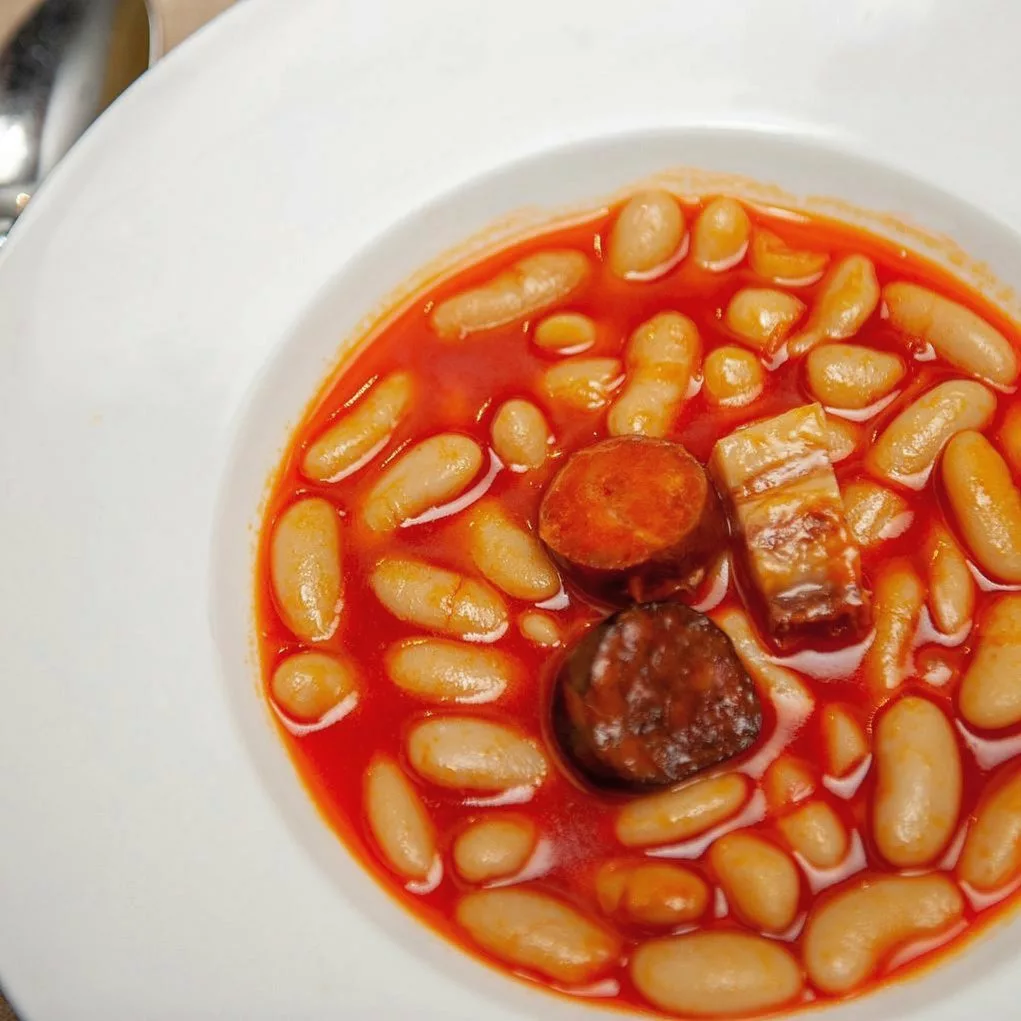
Fabada is one of the traditional dishes from Asturias, Spain. It’s typically eaten for lunch in winter and consists of several kinds of sausages (usually chorizo and morcilla). Chorizo sausage has a reddish-orange color due to being heavily seasoned with paprika, while morcilla is made up of pork blood, meat fat, rice, and onions.
The name Fabada comes from the root word “fabes” which means beans – the main ingredient.
This dish is usually served with cider, beer, or wine to complement its spicy flavor.
Main Courses in Spain
12. Paella
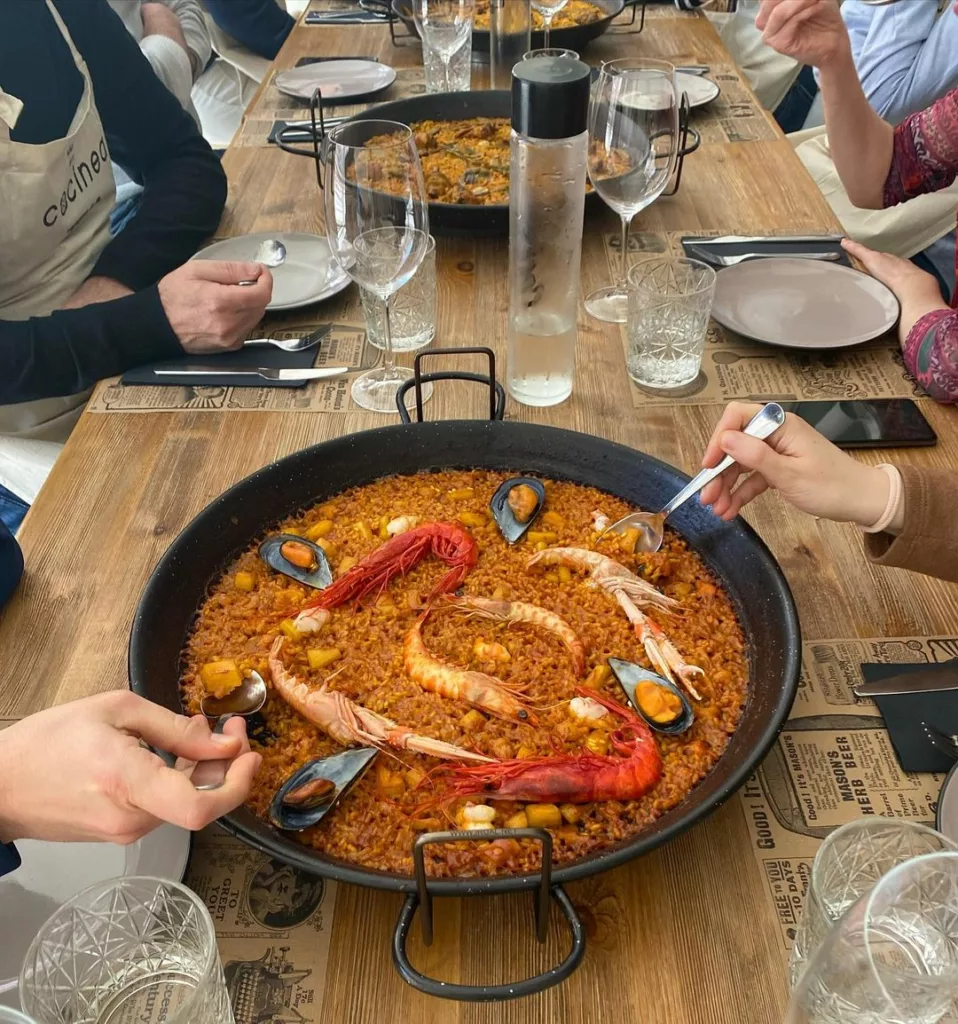
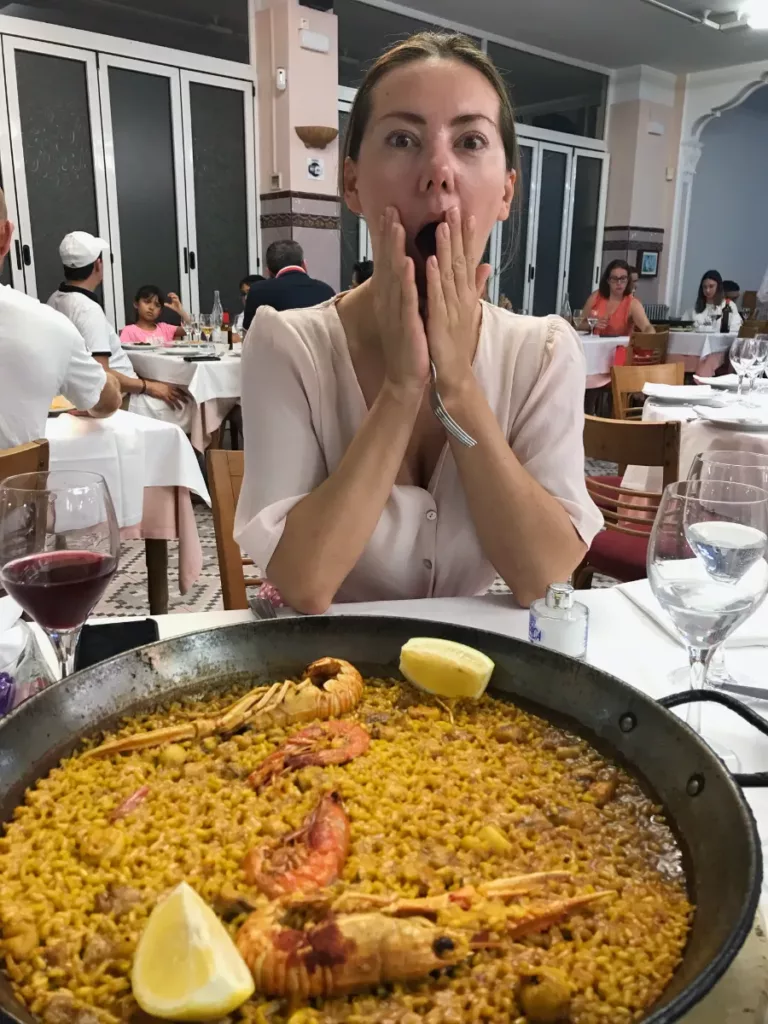
Paella, a rice-based dish, is a true source of pride and a symbol of Spanish cuisine. It is widely known that Spain is paella’s homeland; however, if you look deeper into the history behind it all, you will find that paella was actually born in the Spanish province of Valencia – about 12 kilometers south of its provincial capital – near Lake Albufera.
Rice has been grown here for centuries within marshy fields. It is believed that the first version of modern-day paella originated around El Palmar village on the lakeshore.
The tradition behind consuming this sought-after dish dates back to as early as the first millennium AD. However, what we now recognize today as “Spanish paella,” with similar ingredients to those used today, appeared only in 15th-century cookbooks under its original name: “Valencian rice.”
Paella must be cooked over a fire!
There are many recipes for Spanish paella, and each region of Spain has its own classic version. For instance, Alicante and Murcia lightly fry the rice before adding it to the meat and vegetables. In these provinces, pepper ñora – which should not be confused with paprika – is commonly included in the recipe.
Additionally, pork chops are an integral part of Castellón’s paella recipe. In contrast, sausages and peas replace beans in northern Spain’s traditional dish.
And let’s not forget about authentic Valencian paella, made of rabbit and chicken; definitely worth trying!
Instagram Review
13. Bacalao al Pil-pil
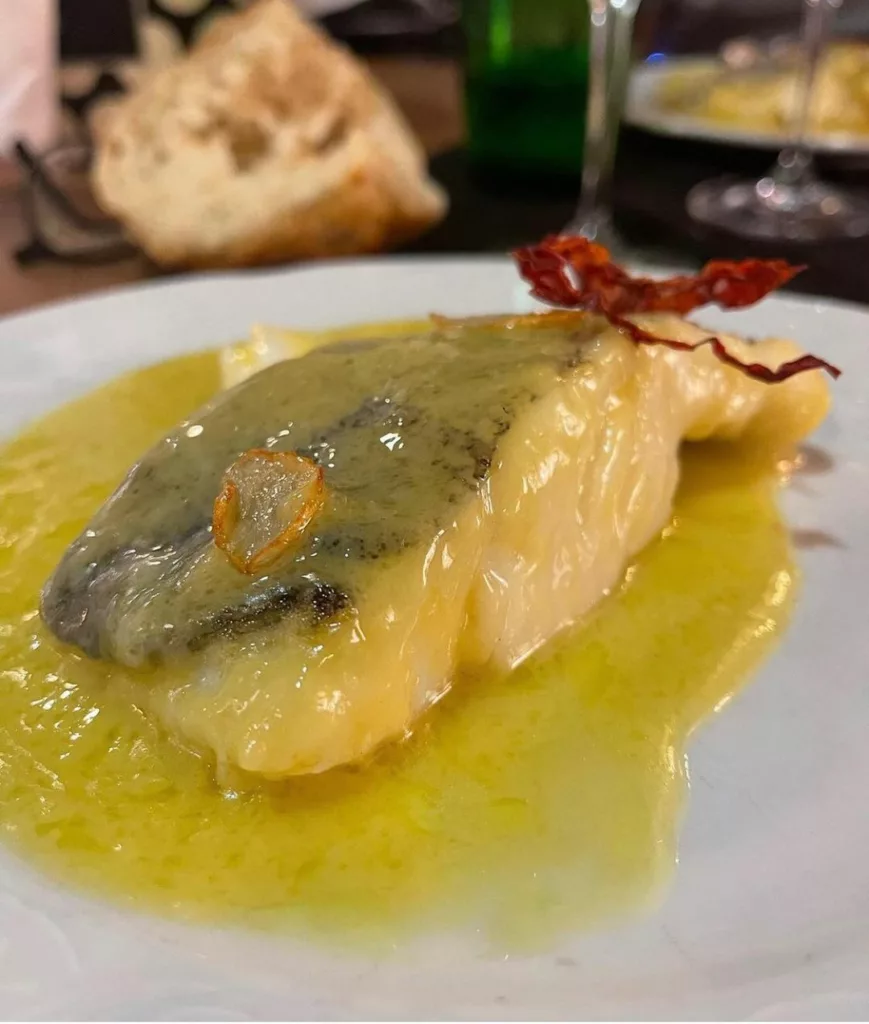
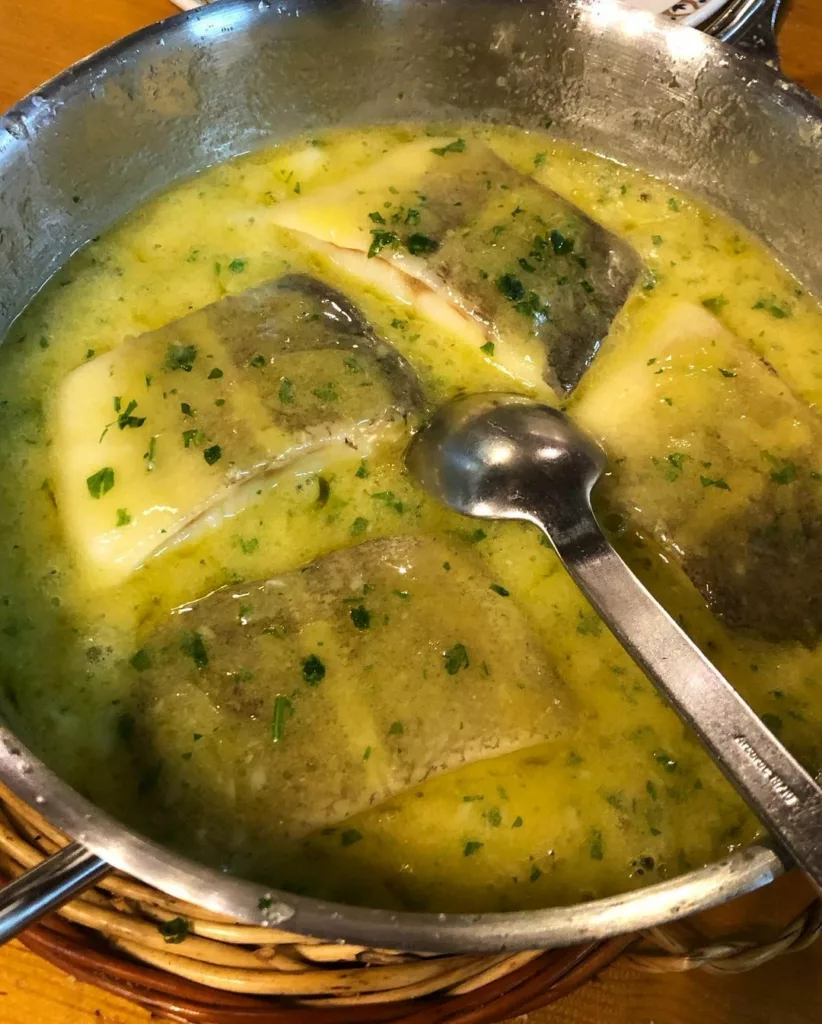
Cod in garlic sauce, or as it sounds in Spanish, “Bacalao al Pil-pil,” is one of the most famous and favorite dishes of the Basque Country.
It does not require a lot of ingredients but a certain patience in its preparation.
Pil-pil is the name of the sauce, which is obtained by mixing the juice of the cod and the oil in which the fish is cooked.
14. Fideuá
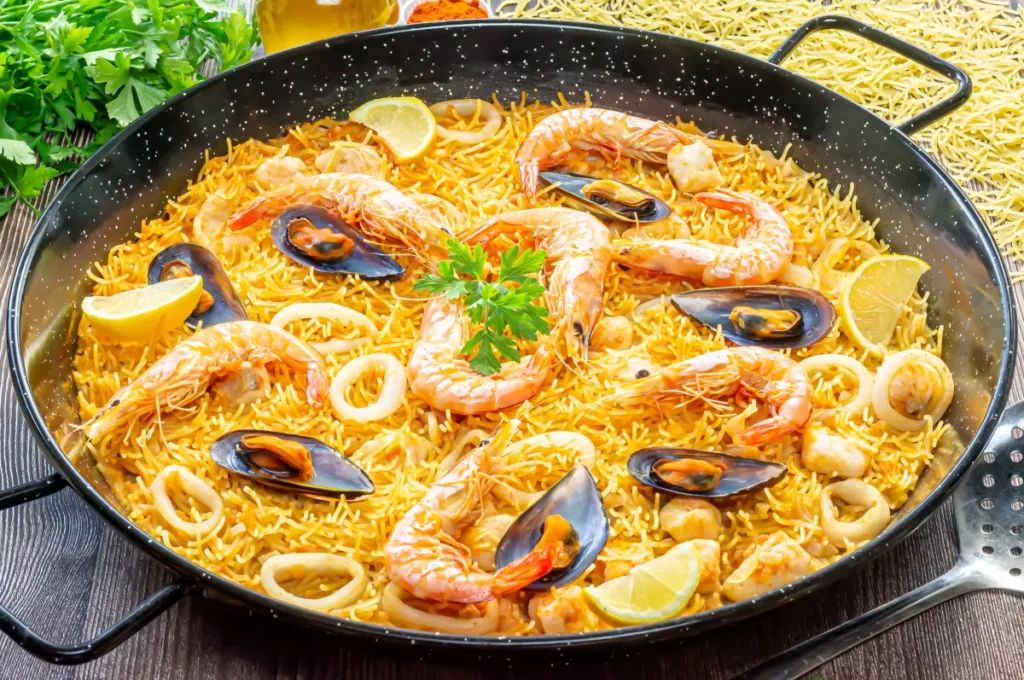
Many have tried traditional paella with rice, chicken, rabbit, and seafood. However, not many people know that there is another version of this delicious Spanish meal – Fideuá – a Valencian dish made using pasta instead of rice as the connecting ingredient.
I was quite skeptical about it at first, but after trying it once, I knew that this dish was definitely for me!
It’s quicker and easier to make than paella, yet just as flavorful and appetizing. The classic ingredients for Fideuá include fish broth (which gives the noodles a fantastic flavor), fish, chicken, seafood, and noodles.
15. Pulpo a la Gallega
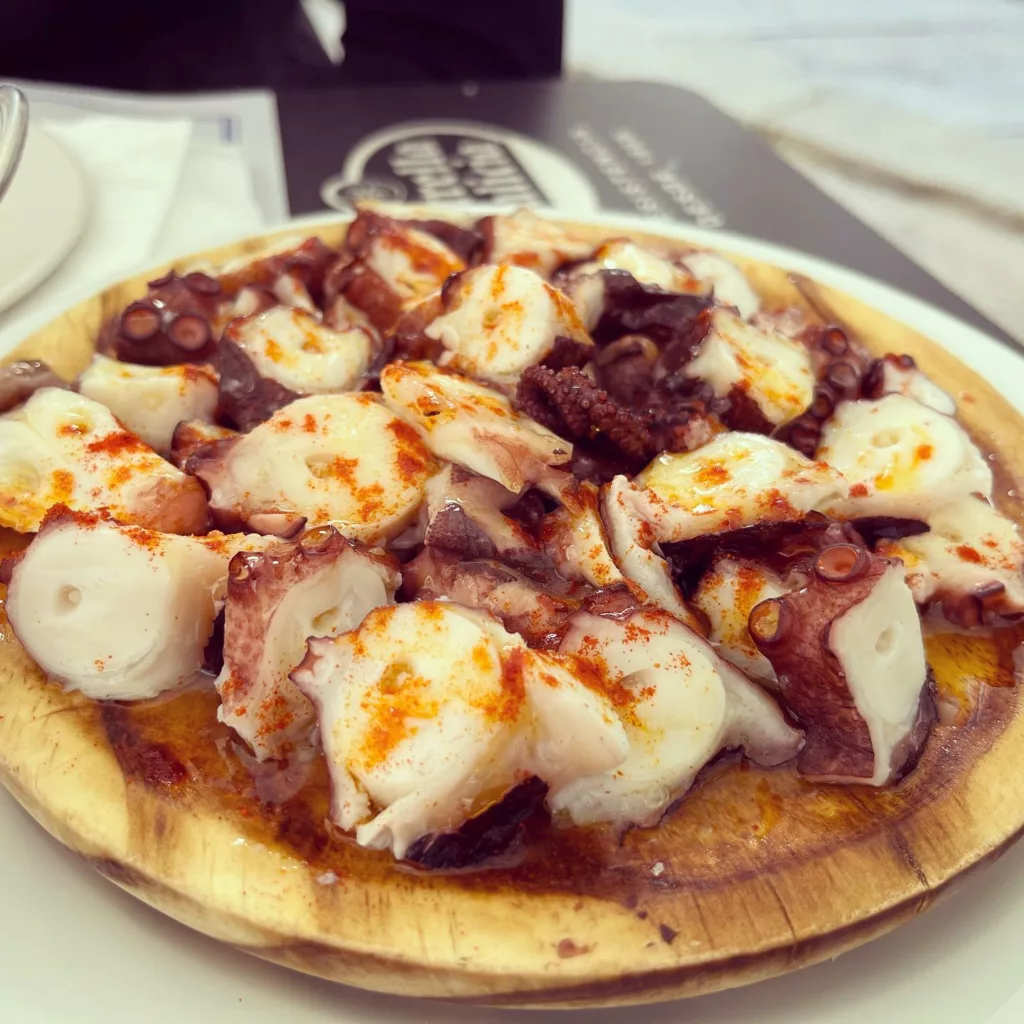
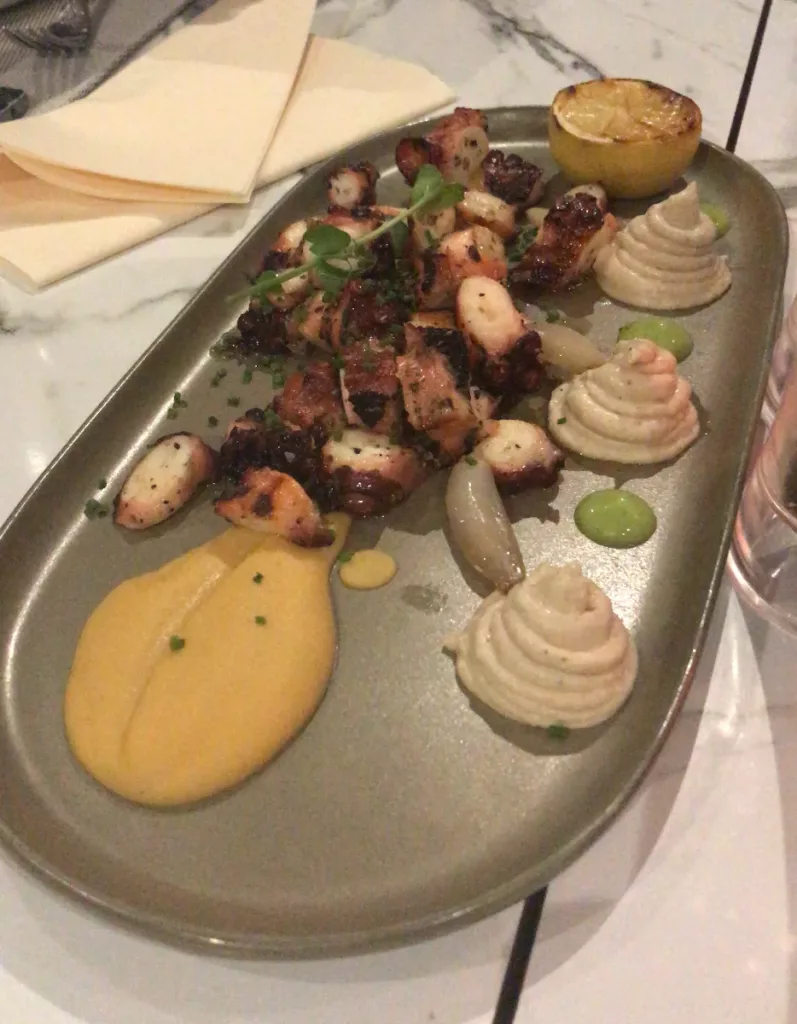
Pulpo a la Gallega is a traditional dish from the Galician region of Spain. It has become so popular that it can now be found in many restaurants and tapas bars nationwide.
Typically, this dish is served as an appetizer (or tapas), but sometimes it may also stand alone as its own meal.
Softness and tenderness are essential to any good Pulpo a la Gallega recipe; paprika, olive oil, and coarse salt are commonly used for seasoning. Additionally, boiled potatoes often accompany this classic dish.
I can confirm that the dish is horrendous if the octopus is not soft and tender 😢
In Spanish-speaking countries outside of Spain, Pulpo a la Gallega goes by another name – Polbo á Feira (although some will mistakenly refer to it as “pulpo á feira”).
Historically, the octopus was cooked in copper cauldrons at religious festivals or fairs (“ferias”).
Spanish Meats
16. Jamón
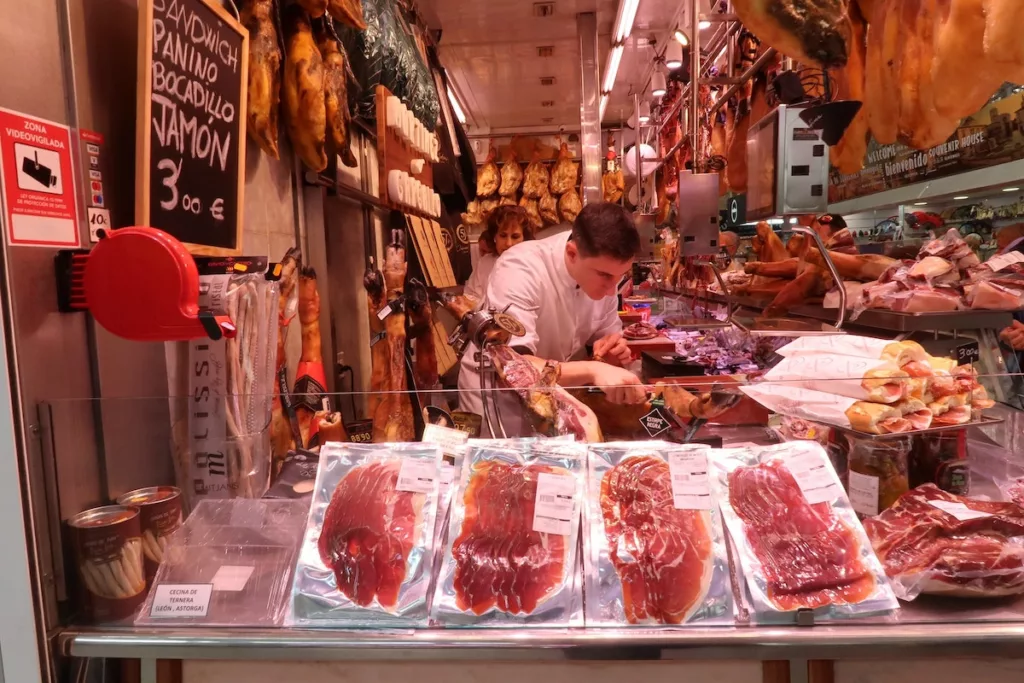
Jamón is an iconic Spanish delicacy that comes in two main varieties (Serrano and Iberico) and many brands produced by farmers or companies who add their nuances. Moreover, it’s sorted into different qualities based on the breed of pig, feed, and place of rearing/fattening.
Jamón is a ham, a hind leg of pork properly salted and cured in natural conditions. According to Spanish butchers, the front leg has an entirely different name – paleta. They even allege that the taste of the front and back legs of the same animal is completely different.
Jamón Ibérico
Jamón from black Iberian pigs is considered the most expensive and refined. To rear these pigs in a pure pedigree, certain conditions must be met:
- The animals should be raised in open pastures rather than pens or stables, giving them enough room for movement even though they may not seem frisky or playful.
- The Iberian pigs should feed mainly on acorns (bellota), so the pastures used for rearing them should have plenty of oak trees.
Jamon Serrano
Jamon Serrano is made from a different type of pig, the white breed. In literal translation from Spanish, “serrano” means “mountain.”
This name indicates that the ham is cured in mountainous conditions, which are climatically and seasonally different from those in the plains.
How to choose Spanish Jamon?
There is only one simple rule: The quality of the jamón is directly proportional to the amount of money per kilogram written on its price tag.
17. Chorizo
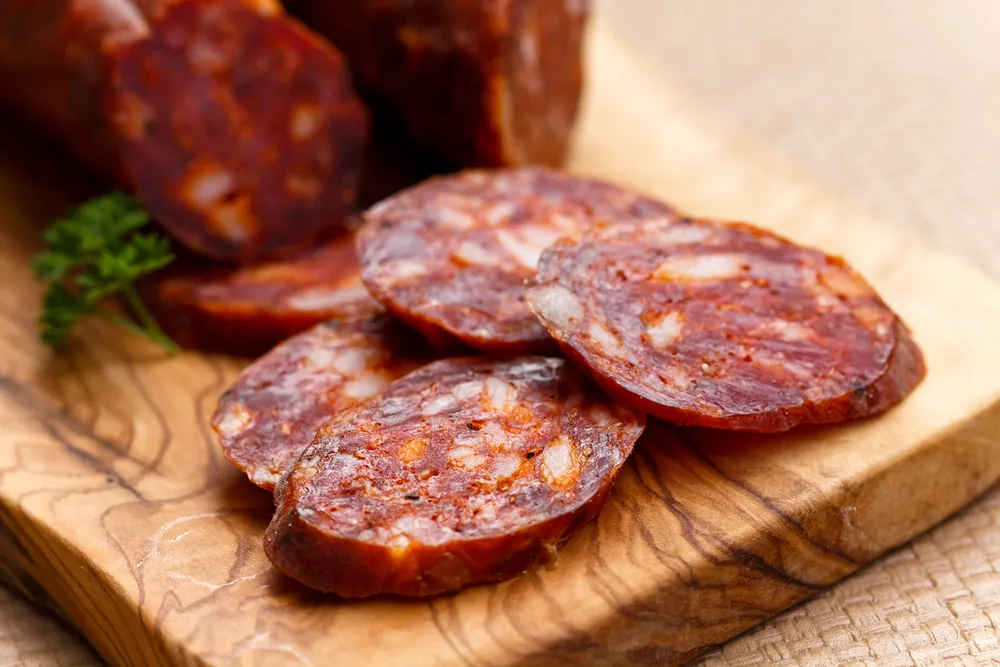
Chorizo is a smoked sausage popular in Latin America, Portugal, and Spain since the 16th century.
This delicacy resembles an ordinary sausage with a dense texture. Depending on the variety, it can be white, dark red, or black.
The stuffing typically contains pork (sometimes beef) and paprika or chili pepper, giving it a spicy flavor.
Chorizo is formed into sausages using pork intestines before being cured or cold-smoked. With 455 calories per 100 grams, chorizo also offers important microelements like potassium, calcium, zinc, selenium, iron, sodium, etc.
18. Rabo de toro
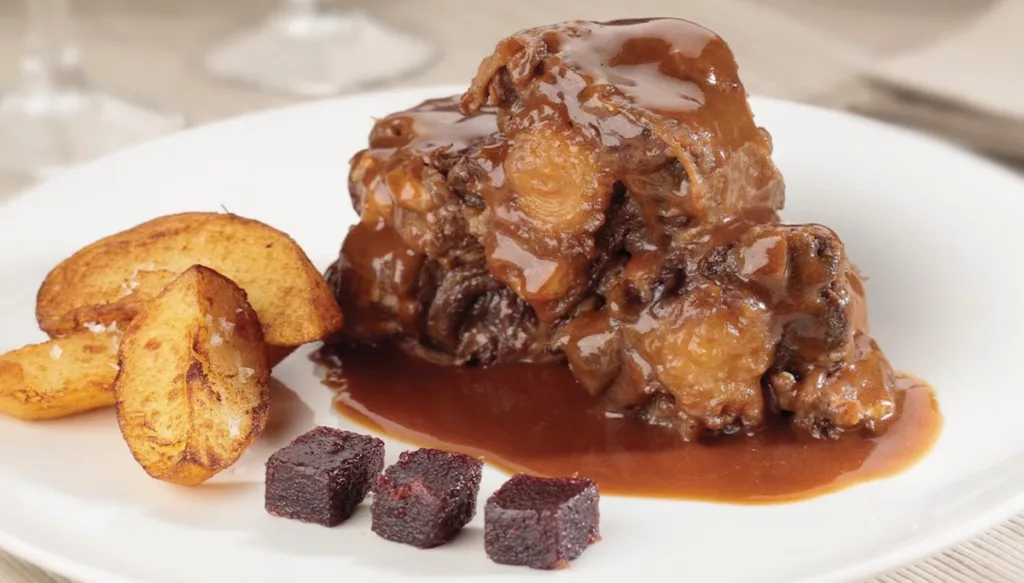
Rabo de Toro is a classic Spanish dish made with oxtails. Braising oxtails is popular in Andalusia, the homeland of bullfighting.
While one disadvantage of using oxtails is their toughness, it can easily be transformed into an advantage: The collagen will dissolve through a lengthy braising process, making them tender and highly beneficial.
19. Chuletón
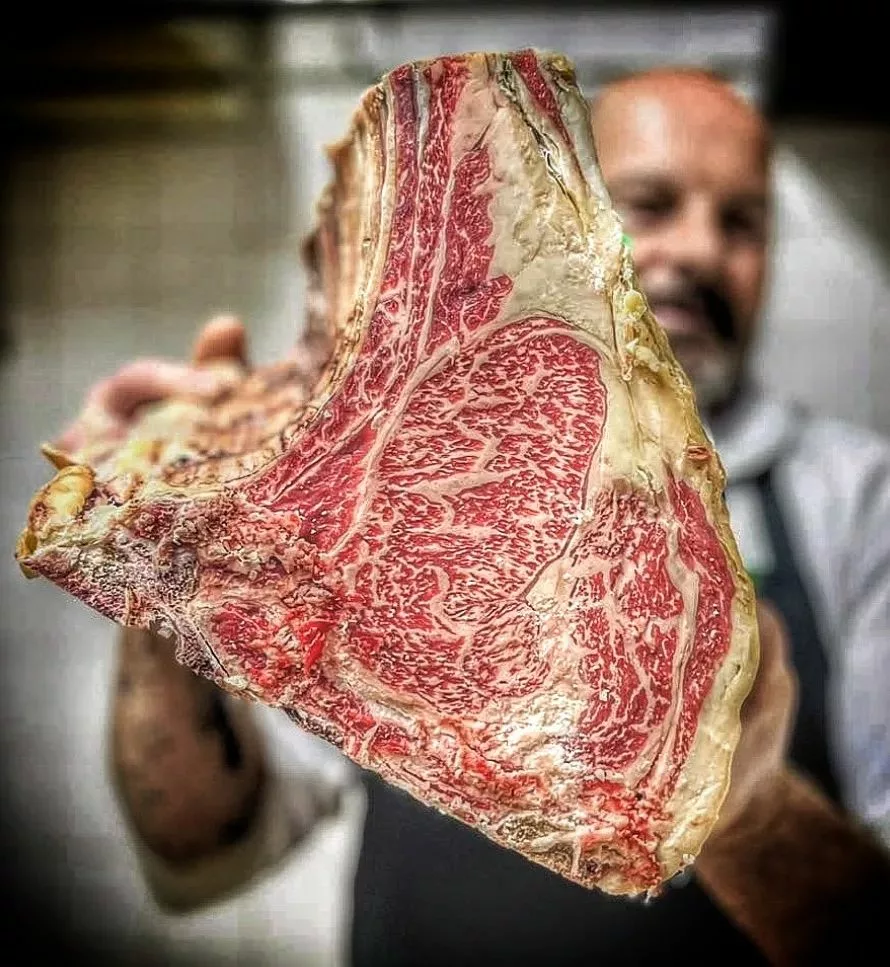
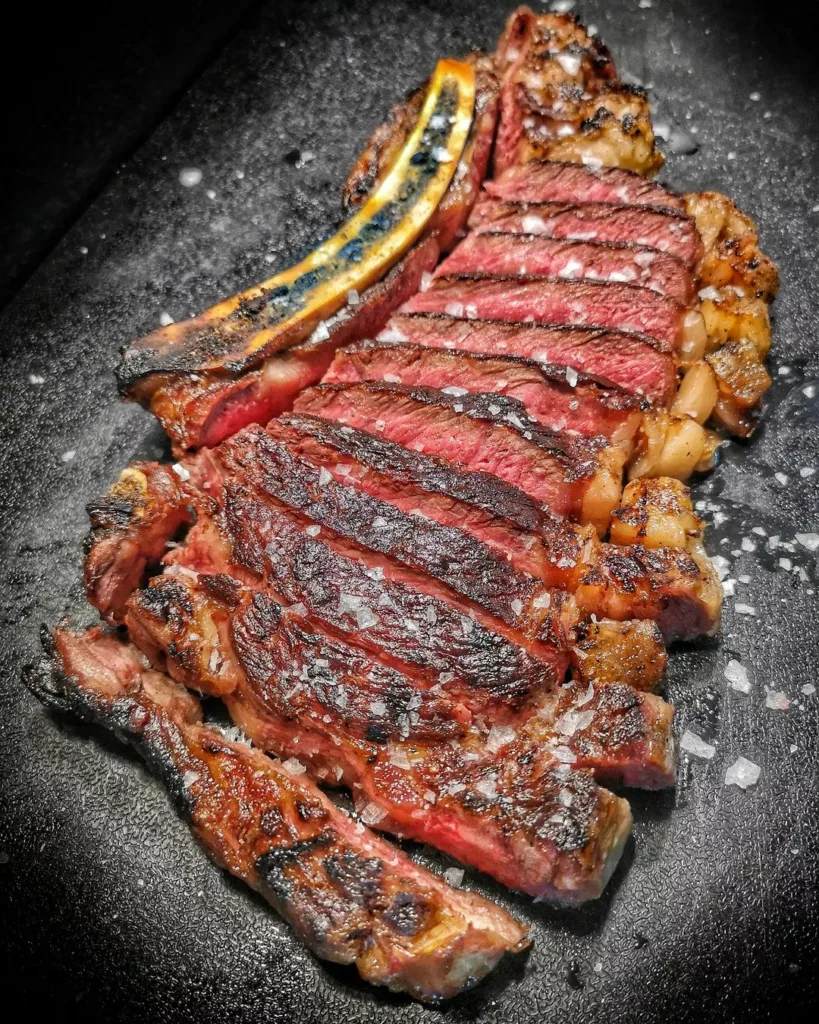
In Spain, the fanciest steak is called a chuletón – a hefty cut of meat with its bone sliced from the spinal section of a steer three years old or older that has been fattened and herded in a particular manner.
Only three elements are used for cooking Chuleton: meat, alder firewood, and coarse sea salt.
As a rule, it’s meant for two people; however, you can make it alone if you’re feeling ambitious!
Interesting fact: Chuletón is a variation of Florentine steak (Bistecca alla Fiorentina).
Spanish Desserts
Oh boy… Spanish people just love sweets, and it is a real struggle for me when it comes to NOT EATING these desserts.
20. Crema Catalana
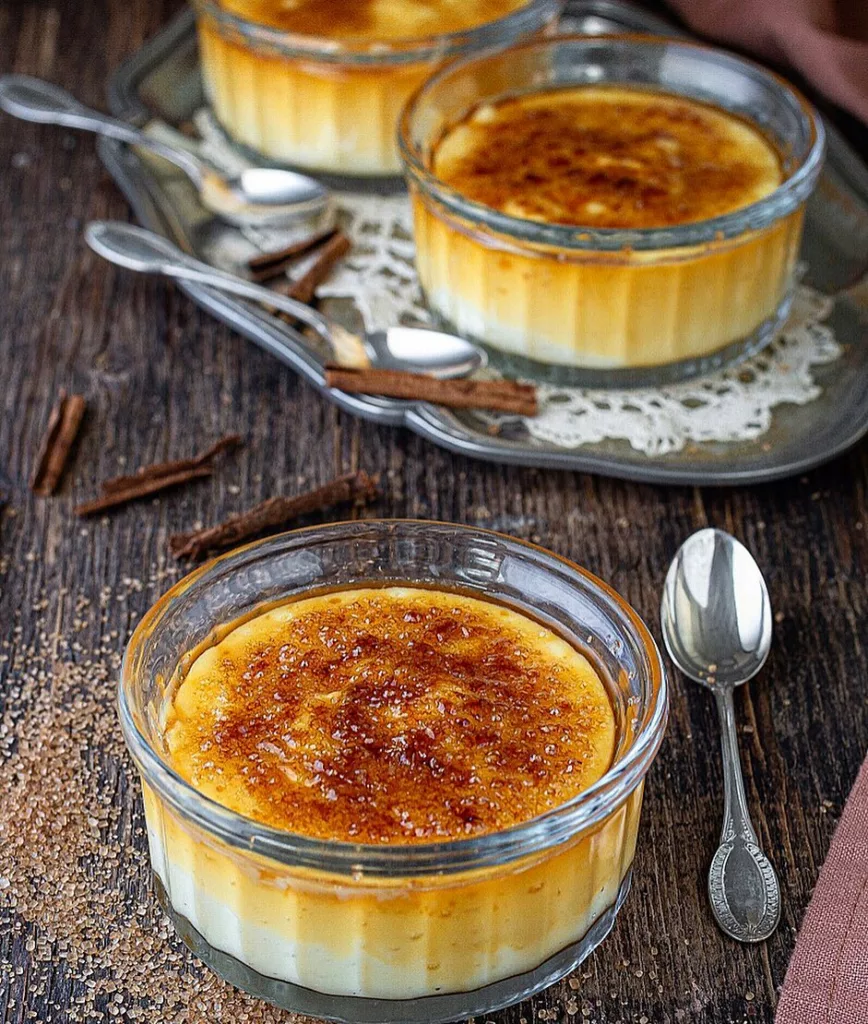
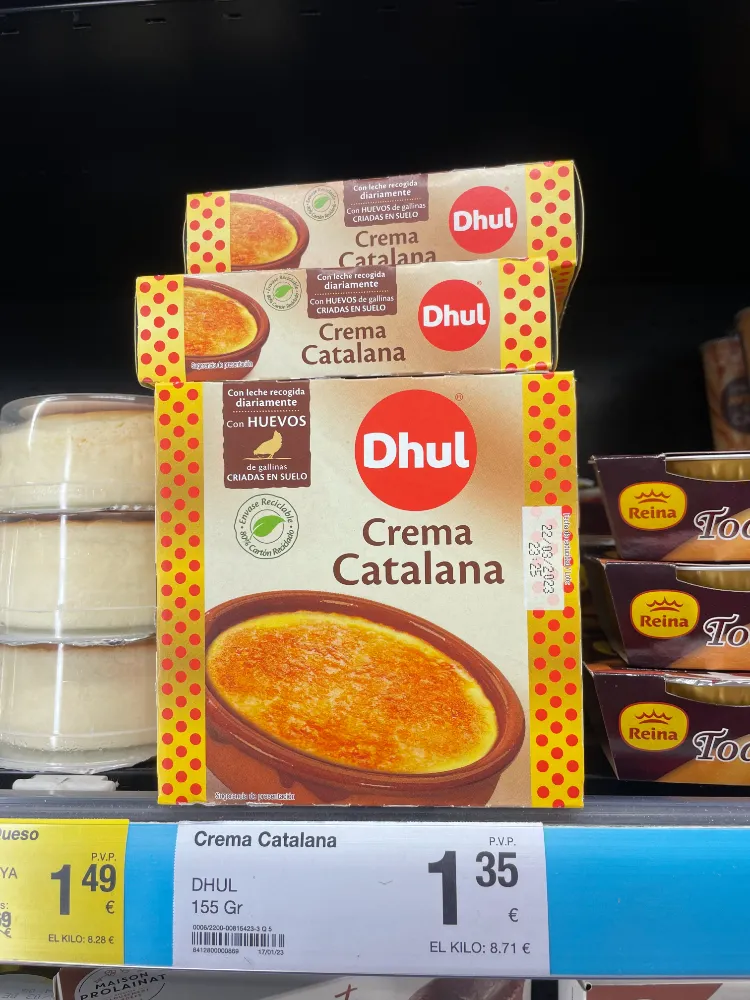
Crema Catalana is an incredible dessert that captures the heart of a true gourmet from the very first spoonful due to its unique combination of opposites: a soft and cool center with a crunchy layer of caramelized sugar on top.
English, French, and Catalans debate who invented it, each claiming credit for their respective people. While there is indeed another similar dessert called crème brûlée, which has slight variations in its recipe, no one can deny the sheer uniqueness of crema catalana!
21. Churros
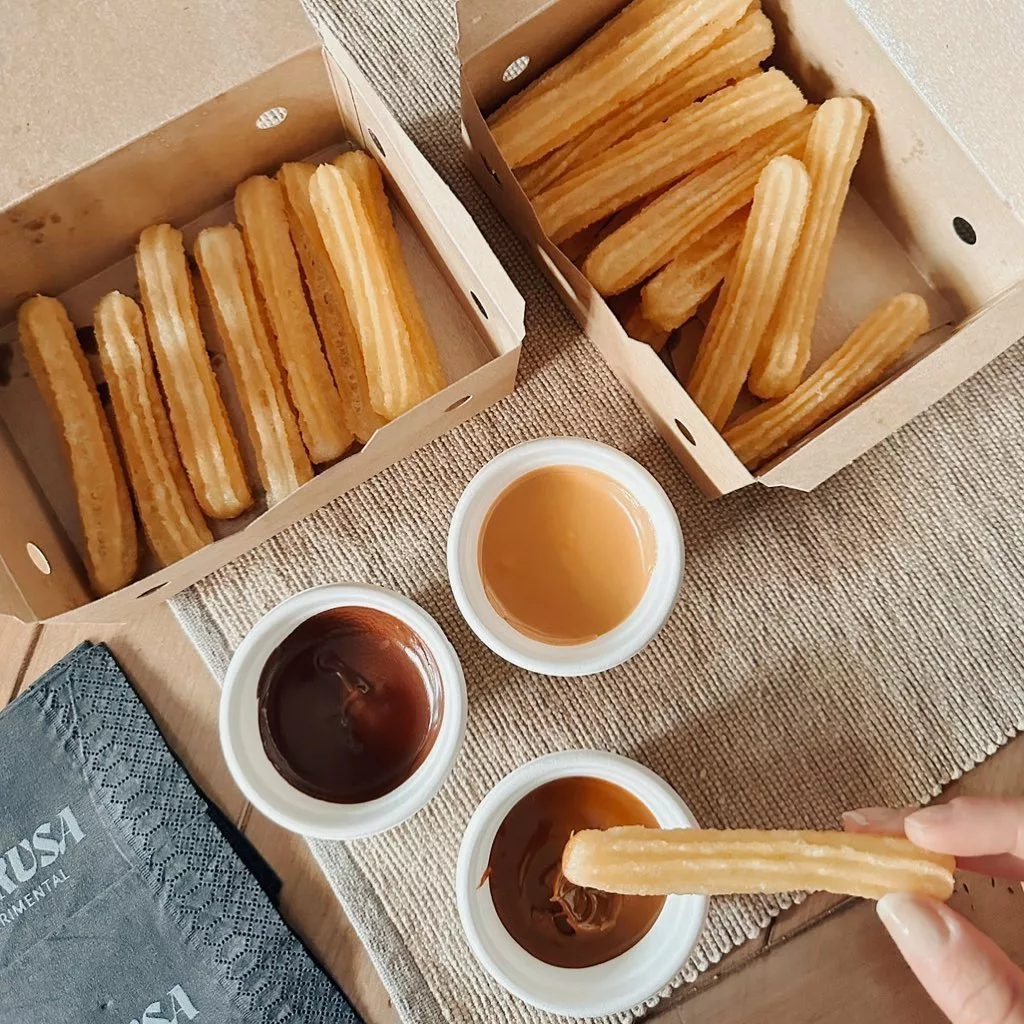
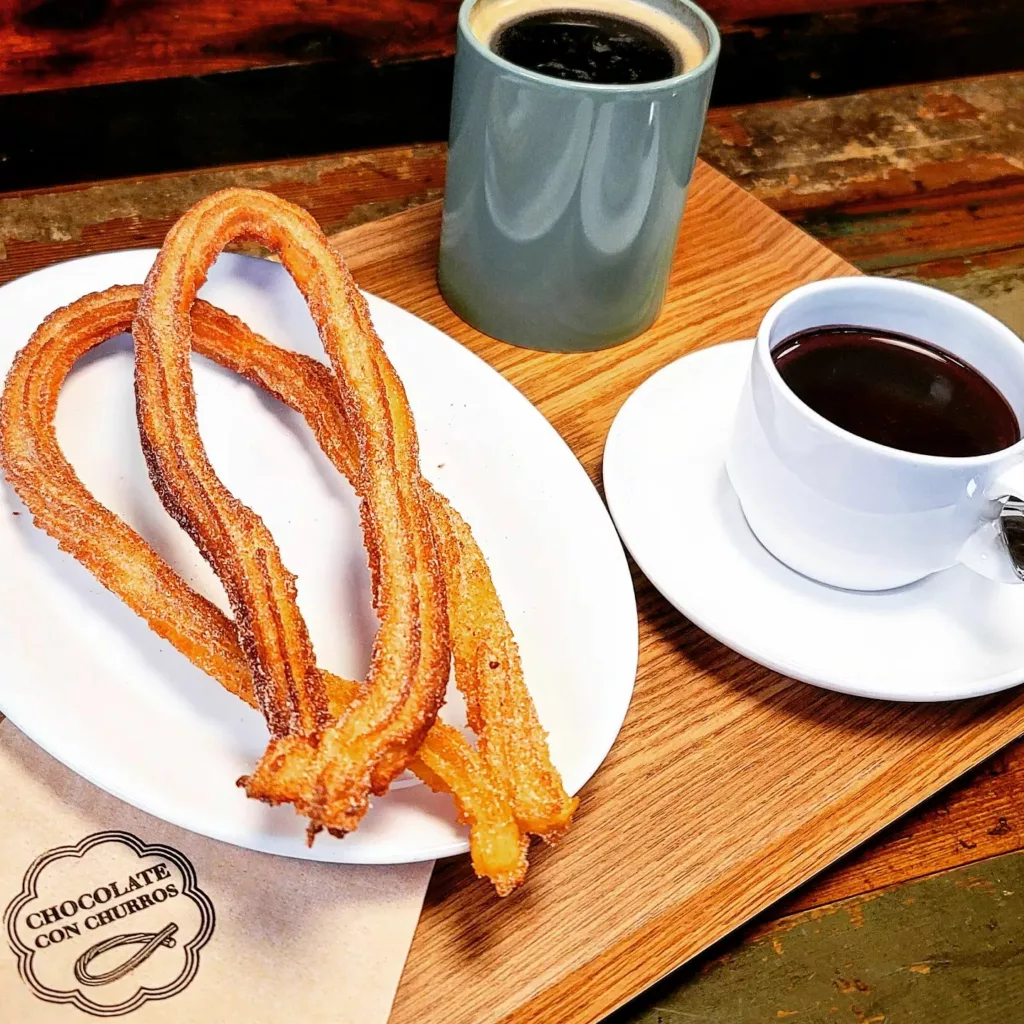
Churros is a sweet pastry made of custard dough with a cross-section shaped like a polygonal star. They are deep-fried and taste a bit similar to doughnuts.
The legend has it that the recipe was invented by shepherds who desired something hot and sweet while out on cold nights.
Originally, these pastries were fried over an open fire in pans; however, they can be cooked in deep fryers or special waffle makers today.
Two kinds of churros are widely known: thin rings and long, thick sticks. In Spain, it is traditional for them to be served for breakfast, along with steaming cups of hot chocolate.
22. Turron
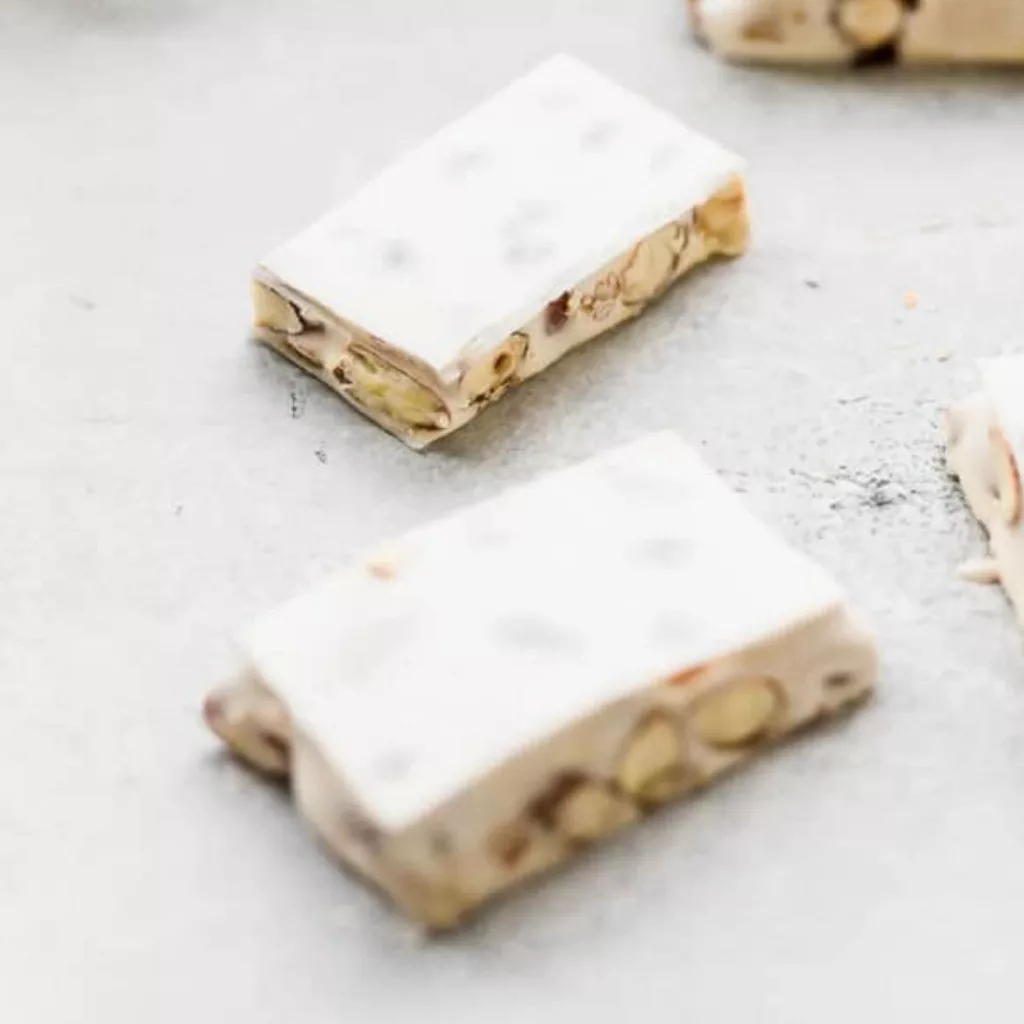
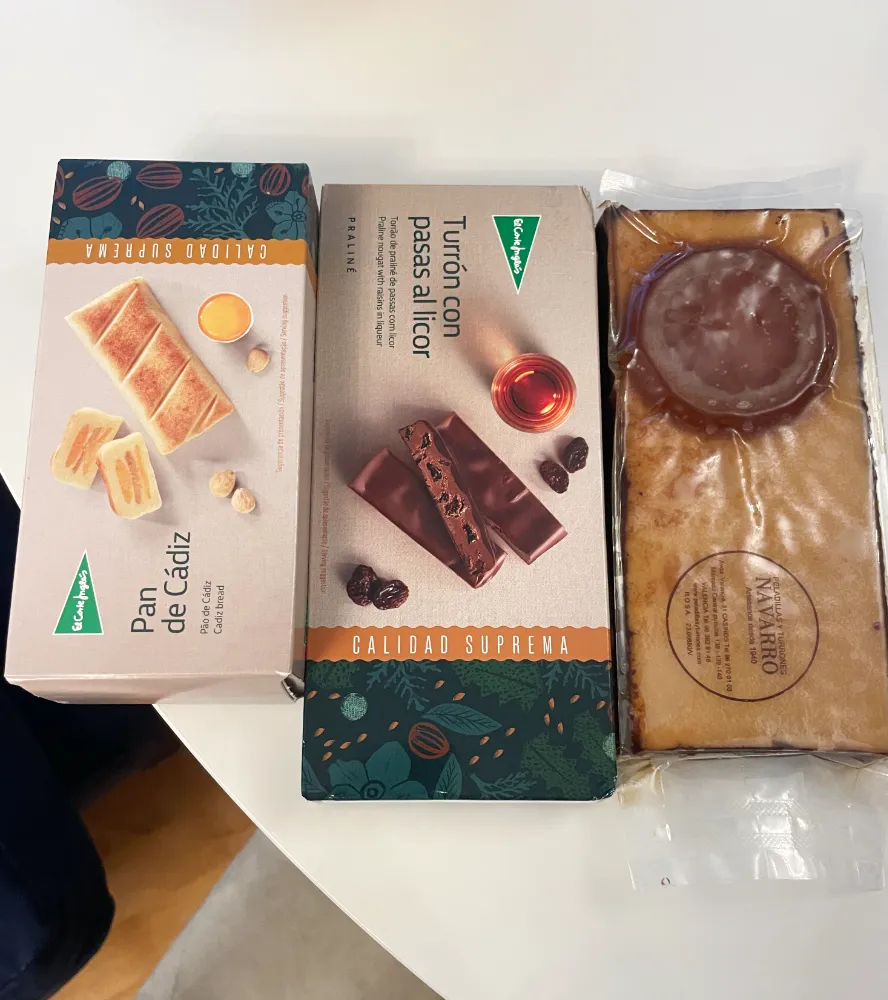
Turrón is another traditional Spanish sweet that comes in both rectangular and round shapes. The recipe for turrón includes roasted almonds (other nuts can also be used), sugar, egg white, and honey.
In Spanish, the word “turrón” translates to “nougat.”
Nowadays, it’s impossible to imagine a Christmas eve in Spain without turrón with popcorn added in, as well as candied fruit and chocolate variations of this treat.
23. Tarta de Santiago (Santiago pie)
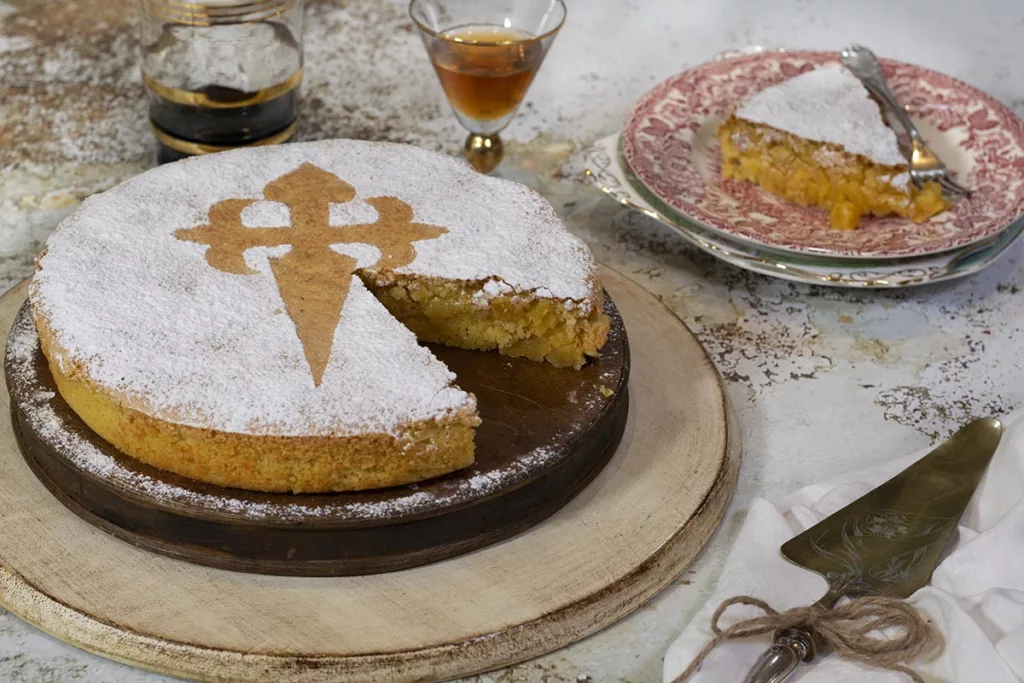
The Tarta de Santiago is a traditional pastry from the region of Galicia in Northwestern Spain. Translated to English, “Tarta de Santiago” means “Cake of Saint James.” This name was given because the capital of Galicia – Santiago de Compostela – contains one of Europe’s most renowned cathedrals: The Cathedral of St. James, believed by legend to house relics belonging to this saint who was a disciple of Christ. This cathedral is also Europe’s largest pilgrimage center.
Santiago pie is simple: almond flour and sugar (usually equal parts), eggs, and flavorings such as lemon zest, cinnamon, sweet white wine, or brandy. The pie is usually heavily dusted with powdered sugar; however, the decoration in the form of the cross of the Order of Santiago remains unsprinkled.
24. Horchata
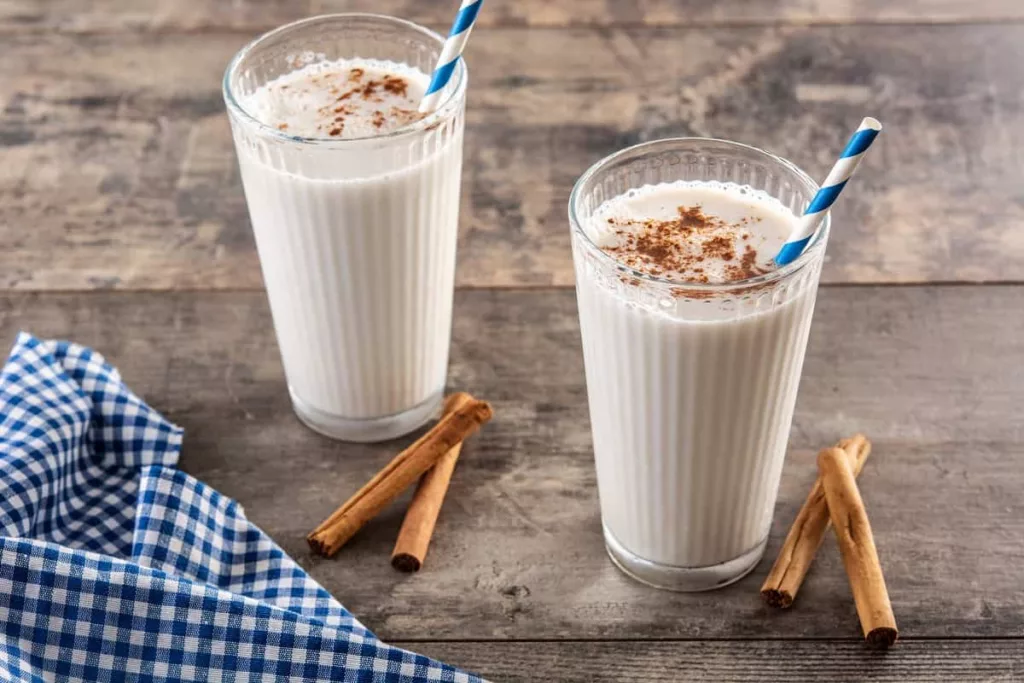
Horchata is the national dessert drink of Spain and is very easy to prepare, and it’s the perfect way to quench your thirst in hot summer weather. Horchata has a similar appearance and consistency as milk but does not contain dairy products.
This traditional beverage is made from chufa roots (tiger nut) that contain nutrition, calories, and a pleasantly sweet, nutty taste. Chufa also has other uses, like being an ingredient for confectionery products or making high-quality natural soap.
25. Tarta de queso (Cheesecake)
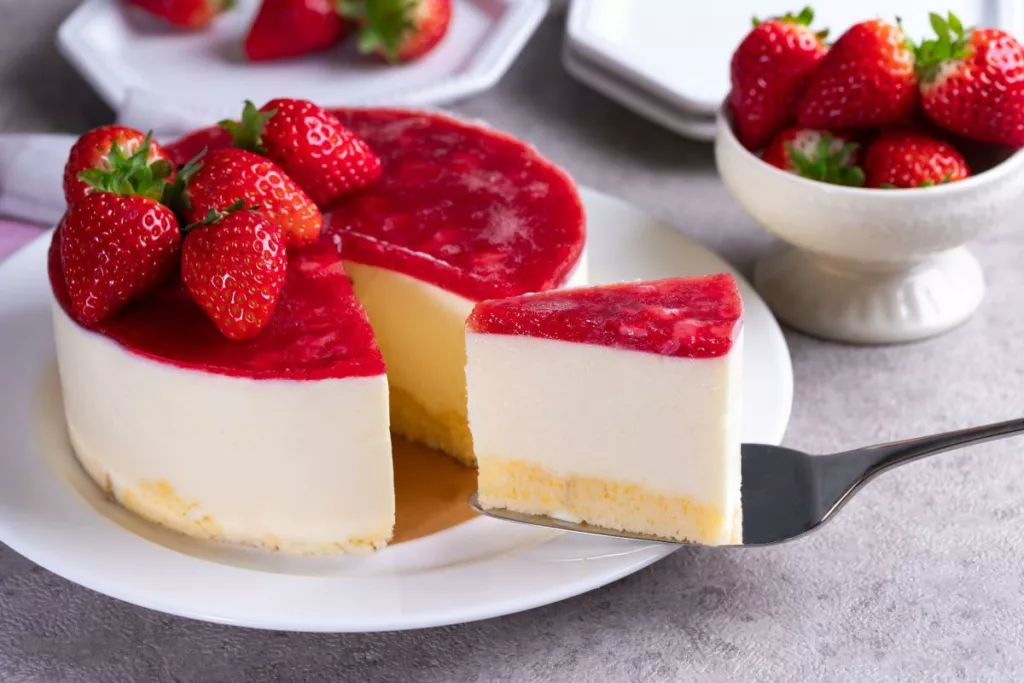
Getting lost in the universe of different types of Spanish cheesecakes is quite easy.
The most popular type of Tarta de queso is made with cream cheese, eggs, sugar, and vanilla extract, all combined to create a delicious custard-like filling.
The base of the cheesecake may be either a shortcrust pastry or crushed biscuits mixed with butter, depending on the region where it’s being prepared. Once baked in an oven, this creamy sweet treat can often be topped with fresh fruit such as strawberries or peaches.
It is usually served cold, but some people prefer to eat it warm from the oven! Tarta de queso is a perfect way to end any meal; everyone will surely love its smooth texture and delicate sweetness.
Popular Spanish food FAQ
For breakfast: Tortilla, Croissant, Coffee, Tomato toast, Jamón with bread.
For “second breakfast”: Coffee, Toast, Churros, Tapas.
For lunch: Salad, Seafood, Gazpacho/Samorejo, Tapas, Bacalao (Cod), Paella, Wine/Beer, Coffee. Spanish people don’t eat paella for dinner because it is to heavy.
For dinner: Tapas, Chuletón (or other meat), Pulpo a la Gallega, Alcoholic Drinks, Desserts (Crema Catalana, Tarta de queso).
1. Paella
2. Tortilla española
3. Patatas Bravas
4. Gazspacho
5. Chuletón steak
It is either red wine or beer. Don’t listen to anyone who says it is Sangría, thats not correct. Locals do not drink Sangria in the most situations.
My Other Post About Spain
- Best Seafood Restaurants in Valencia
- Best Seafood Restaurants in Barcelona
- Best Breakfast Place in Barcelona
- Best Breakfast Place in Valencia

2 replies on “Taste of Spain: 25 Must-Try Traditional Dishes”
Amazing post. Everyone should try the above yummy as well as healthy food in spain.
Thank you, Joefinn! It is healthy (unless you eat lots of churros)!